Copyright Michael Bevilacqua 2010-2026
You can contact the publishing agent regarding media interviews, requests for speaking engagements, or copyright information.
write to: info@beyondthedreamhorse.ca
Here is the complete series of the FREE Beyond the Dream Horse monthly articles for 2012
The archived 2011 Articles Series are still available for pdf download or web viewing here
Article titles from 2011: Mismatched Socks, The Missing Link, The Fragile Leaf, A Changing World, The Future is Now, Romantic Notions, Pushed to the Brink, Mirror Mirror On the Wall, The Human Masquerade, Know Thyself
Dos artículos en español
Deux articles en français
A Shared Star
December 2012
by Michael Bevilacqua
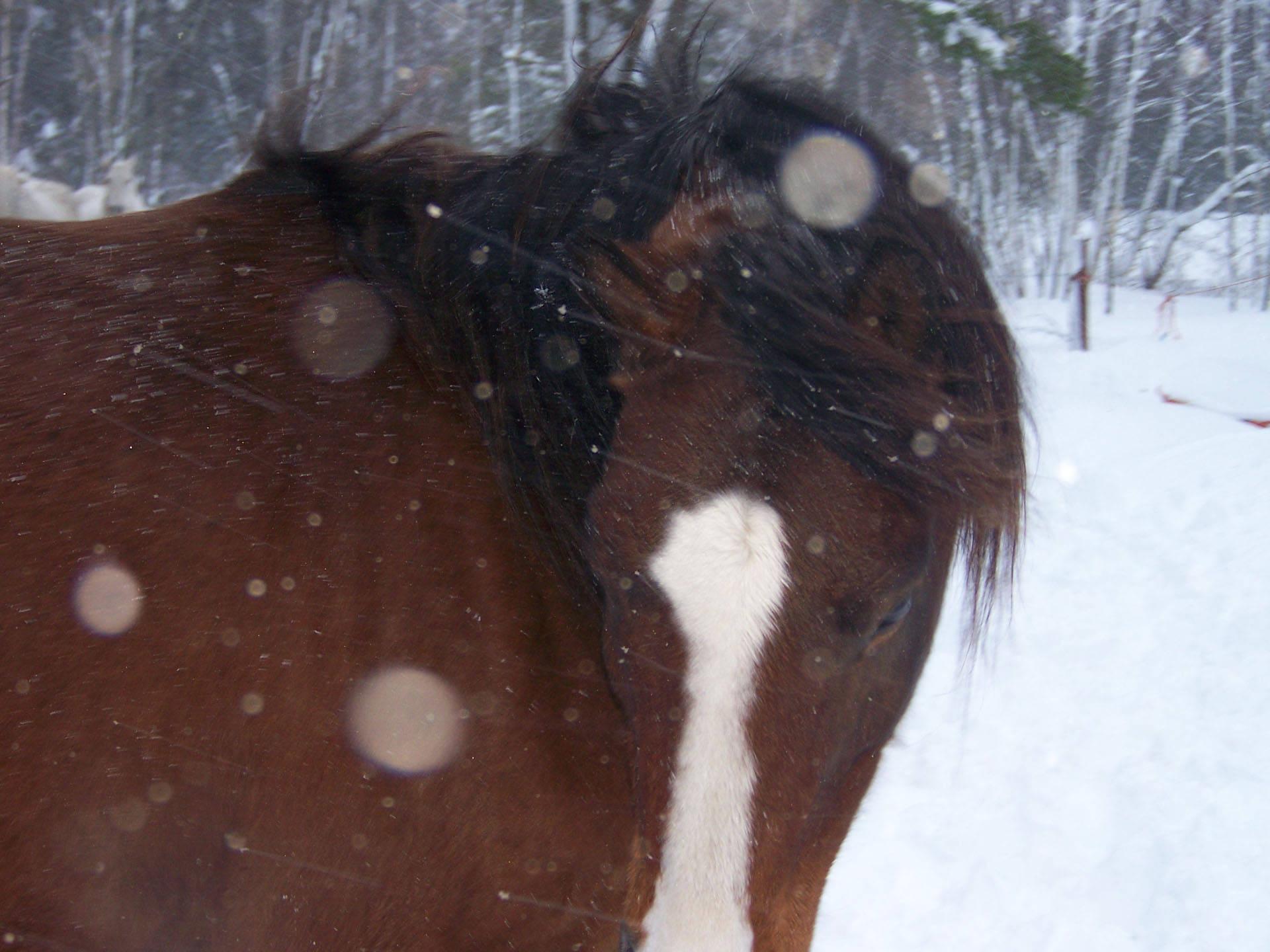
Dec 21st - Primo insists on staying with me while shoveling a path to the barn
The last article of 2012. Who has not realized that time flies so quickly? Maybe only those who have covered a significant amount of time already. At a certain point, twenty years can make a big difference. Lives can completely change. Twenty years ago can seem like a dream or some other life.
I remember, once upon a time, saying, “If people, ten years ago, told me that I would make a life involving horses, I would have thought that they were crazy”.
Have you ever wondered if different circumstances in your life would have ultimately changed your future? Rather, your current present. Are there different routes to one's destiny? I believe so.
This road has not been without various difficulties, to say the least. Is it, or was it, my destiny? I do not know. In the course of all of it, I have learned so much about myself; discovered a side of horses and people and related tangents to which I would otherwise, possibly, have been oblivious. Then, if one speaks of destiny, the question about the experience and path inevitably arises – why? What was the point of all of this? What was it all for?
I do not pretend to believe that this even is my destiny. It was choices.
Is there an event that could have changed your future completely? Perhaps, a person that you met or did not meet, at the right place; at the right time? A choice of school, where you chose to live or accepting/declining a job offer?
In elementary school, when the boys were saying that they wanted to be a policeman or fireman, I wanted to be an astronomer. Looking back now, I do not know why I lost track of that. Maybe because it was already considered by friends, teachers, as odd. I was too young to understand that different was not necessarily bad.
Asking children what they want to be when they grow up may not be the proper way of phrasing the question. It seems to imply becoming someone other than who they are.
Important Echos
I have written about ripples or actions that can have a real effect on other people's lives. Operation Ebook Drop provides free ebooks to coalition and peacekeeping troops around the globe. As a contributing author to Operation Ebook Drop, created by Edward C. Patterson, in cooperation with Mark Coker, founder of Smashwords, a note came to me one day.
If this article series of 2012 exists, it is because of a certain major, stationed in Afghanistan, when she wrote me a 'thank you' in August 2011. It helped me realize or reminded me, that what I was doing did some good somewhere for people and gave me the determination to carry on. She made the completion of the article series 2011 possible. I have always received notes of thanks and appreciation. Maybe I was just having a rough time and a bad day. Maybe it was just timing. If it were not for her message, all would have ceased to exist, at least in my world, in August 2011. Thanks to her, lo and behold, Words of Truth and Horses was born and continues today.
As the September, 2012 article, Stepping Stones, states, small actions really do make a big difference.
Choices always exist. You should pursue in life that for which your spirit longs. You should not live with any regret. It is never too late until there is no more time. Once our parents, aunts and uncles are gone, then we become the graduating class. I once read, or heard, somewhere, that it is like walking with all the people you know across thin ice. You never know who will disappear next.
Therefore, I continue to write and live with horses in a little corner of paradise. Things may have been different but I am thankful to be where I am. Thankful for the horses as they have also inspired my life and never gave up on me; the joy and peace in when they silently gather joining me around a campfire under a starlit night in a frozen field. Thankful for the people who share a note, story or comment about themselves or their horses. Now, no matter how rough a day or period is, I am thankful that I sleep under my own roof in a comfortable bed, with all that I cherish all around me – both near and far. For, as I look up to the sky, no matter where we are, I know that we share a star.
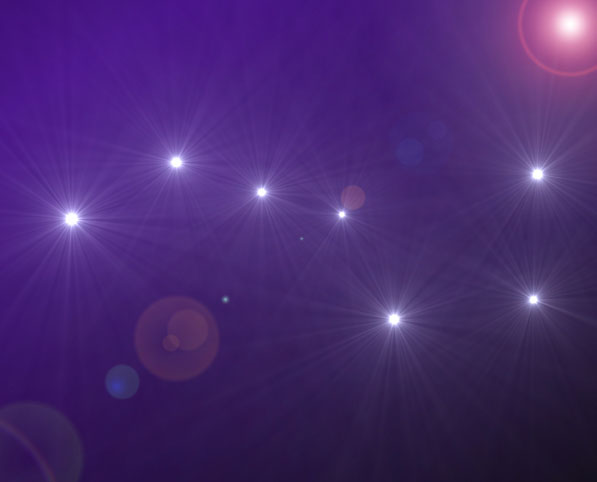
Illustration: Big Dipper: by TheGame: www.dreamstime.com
References:
Smashwords: Smaswords Supports Operation Ebook Drop
Unconditional Love
November 2012
by Michael Bevilacqua
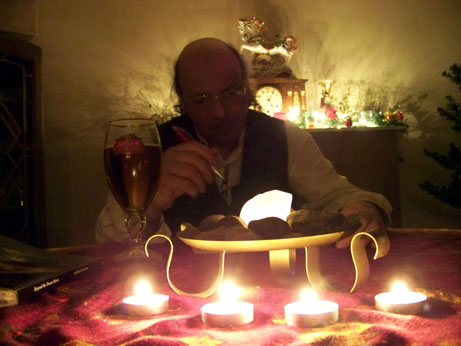
Thoughts to paper - Michael in typical writing mode
In relationships, human or with horses, there is nothing more beautiful, rewarding and reassuring as unconditional love. Maybe that applies to how we may think but from the horse's point of view it could simply mean care, tenderness and honesty. Such are the qualities and beauty that I have appreciated and shared with horses.
With horses, you cannot control an independent heart but through being respectful, it is usually reciprocated and you can earn the respect, trust and faith for who you are and what you do.
There is often mention of people anthropomorphizing animals. That can happen, sometimes. However, there is nothing wrong with us being human and maybe, sometimes, recognizing similar traits in horses. They do exist: playfulness, boredom, sadness, anxiety, fear, displeasure, protectiveness... Horses can learn and relate to us as we are. It is part of the beauty of the subtle, quiet relationship. No matter what we think, it is allowing something to happen. It can happen no matter how we perceive the reality before us. I do not think that horses complicate their perception of humans through equinomorphizing. From the perspective of horses, it is our intentions and actions that they clearly see and must directly face.
Using such terms, even invented, is where reality is circumvented. You can come so close but pass right by. We can miss it because we start to analyze and think about what we think we know about another species. We try to pigeon-hole everything. We do not even fully understand ourselves through scientific analysis on so many levels.
A winter's day brought a gift of fate. Not too old to see yet so blind to the path before me. Somehow, there was a sense within when I first saw Big Leo. I chose my first horse over anything that I believed I wanted or thought that I needed. He made me feel that I needed to choose him, when he was not even on my list. A 'dream horse' can come in all shapes, sizes and colors, if we only take the time to listen.
What has not been said, learned, studied, retracted, modified, revised, updated, discarded, re-discovered about horses? Yet there still exists much contradictory information on different subjects about the horse. Horses are just fine doing their own thing. The biggest mystery is within ourselves.
I do not want to write some deep, philosophical soliloquy. I want to write simple words to which anyone can relate. I sometimes have to remind myself to connect right back down to earth. Study and learning is good but I do not want to be an armchair horse person.
All people are, deep down, the same. There is a chord that can be struck across all humanity. There is so much to be said and, oftentimes, our troubles have nothing to do with logic. The book, these articles reiterate upon themselves. In trying to simplify through ongoing explanations, maybe all has become too complicated. Emotions and the beautiful simplicity can overwhelm me. Yet, trying to slowly funnel an experience through the tip of a pen can cause such a bottleneck where simple words elude me.
My ambition is to help people see the similarities between species. As being part of nature, to have an honest approach with nature. Respect within and respect without. The human mentality toward 'animals' remains our greatest barrier.
Is showing a horse not to be afraid of something desensitization? Could it be simply presenting something new, and, the horse trusting you, learns what that thing is and that it is something not to be feared? Think of how you would relate to your own child, real or imagined. Trust and understanding have nothing to do with training.
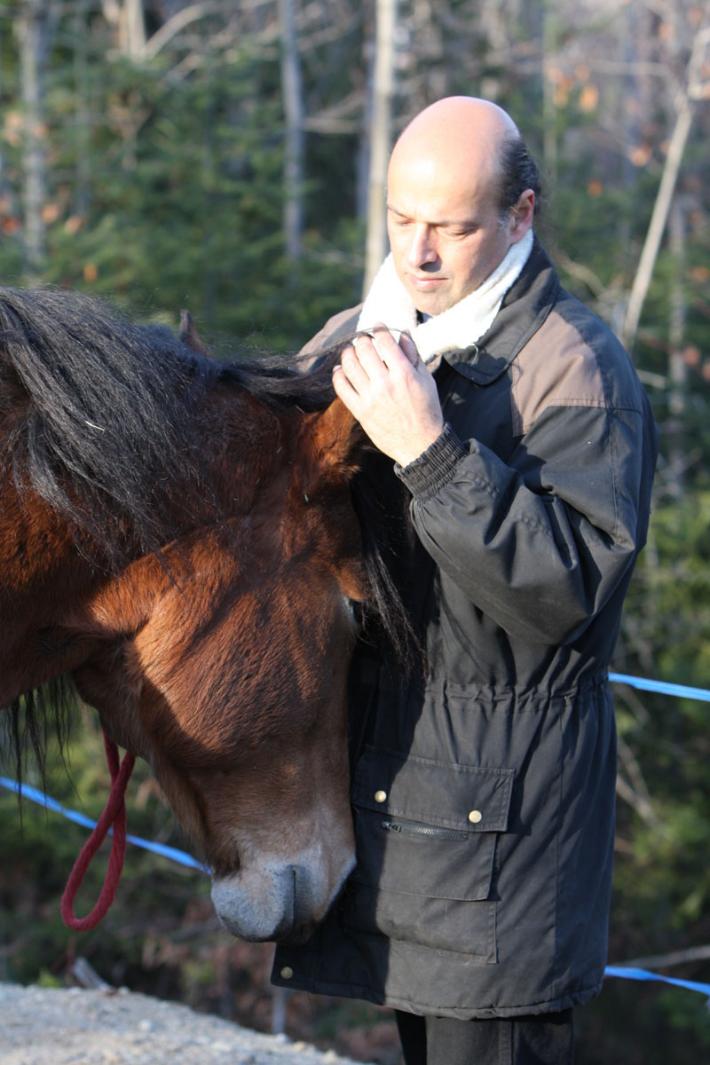
Trust and understanding have nothing to do with training
Photo: Catherine Scott: Seminar 2008
As a small example, I have had my foray into clicker training in the past and in my workshops there have been clicker trainers who were looking for something different. What is extremely interesting is that in normal interactions with horses, when the horse would do something in the perceived desired way, the 'clicker trainer' would automatically make a clicking sound with the tongue. It is funny at first. Yet, even though the person would be consciously aware of what they were doing and should stop doing, they could not. Every time a horse did something close to understanding what was being asked, the person would uncontrollably make that clicking sound. It began to drive them crazy. They realized that they had conditioned themselves. It was a hard habit to break.
If this is all about letting horses express themselves and have a real interaction and a real relationship, then it also applies to people. So many words and terms have become so popular in regard to 'working' with horses. I think that many of those terms should be guided toward people. Relationship, trust, respect, empowerment, expression, willingness, freedom.
If you just 'be' and let your horse just 'be', you might be amazed at what will unfold.
When it comes to horses, it has been mentioned in previous articles, that if all needs are satisfied, only then are they ready to progress to another level. That is already part and parcel of building a relationship. It is not unlike caring for your own child. When they are healthy and secure, they can learn anything new. You are responsible for that and that is simply a small part of the ensuing potential that you can come to discover about your own horse. It is part of the challenge of discovering yourself and how you can bring good things to those around you.
Although I have been interested in, and tried, meditation, I cannot sit still and clear my mind. If I need to reflect on something or find some answer, I need to do something that is completely off the subject. Cleaning the barn is my form of daily meditation. Focused on the task, working toward a satisfactory end, clears my mind of all else or lets it quietly simmer. Time flies and somehow, at the end of it, there are realizations or conclusions that have peacefully formed within me.
In coming across a piece of information about what you can do with or for your horse, to which you can relate or find interesting, you must acquire the notion through action. Buying a book or reading a web page is not good enough. You must go out and be with your horse and bring forth what you want. You assimilate the learning through action. You must turn the 'information' into 'knowing'.
In doing something new or different for what I feel or that I truly want, there is always some uncertainty. I prepare myself with the best informed actions that I can. There are times that mistakes are expected and I look forward to them because they also give me answers. There are also times when informed decisions conflicted with what I felt should be done in the moment. Those were, perhaps, some of the most illuminating experiences I have ever had.
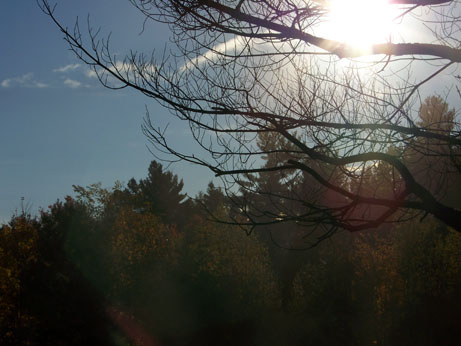
Our most cherished moments are often quiet, beautiful memories and not spectacular events
Photo: Monica Bretschneider: www.monicasartstudio.com
Bridging the Unknown
October 2012
by Michael Bevilacqua
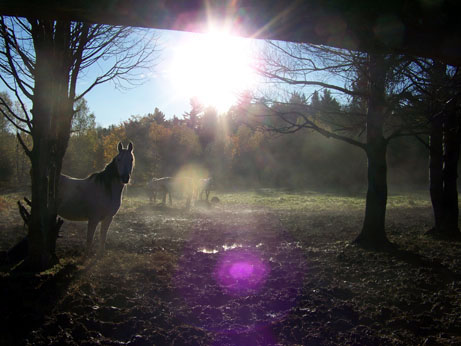
Early morning field after a rainfall
Our mind is filled with various concepts and beliefs. A concept can be overlooked or misconstrued because a person holds their own beliefs as to what is right. If openness to other ideas is lost, so it follows that seeing clearly what is right in front of you is also lost.
Learning is about viewing or receiving information without analyzing or judging. Analyzing can too often lead to personal associations and become misleading. Teaching or education is really about drawing forth from the student. It is an objective acceptance of what is around you and not a definition in a written paragraph. The two can sometimes go hand in hand but the reality, or rather, the experience has to flow through you.
Even in 2012 we are stunted with ideologies, simplified traditions and inherited, erroneous concepts of all kinds. Some older concepts of reality or factual information about the world around us, going back hundreds of years, can hold more relevance, clarity and substance in their simplicity.
These articles stem from, and expand upon, a single paragraph or sentence from my book, Beyond the Dream Horse. Topics I rarely write about come from the chapter with the same name as this article. On one hand, such subjects are quite complex and diverse in terms of scientific research. This article has nothing to do with wishing or guessing about the wonders and beauty within life. People dedicated to learning and science have made abundant discoveries in many fields in what was once believed to be simply fanciful thought.
One example is precious stones that are used therapeutically. Everything in this world has its physical molecular structure but also produces an energy field. This energy is influenced when in proximity to other energy fields. These fields are measurable by science. In measuring the field of a healthy person in comparison to a sick person there is a noticeable difference between the two. To simplify to a physical correlation, think of a battery meter: there is an indication of low or fully charged and ready to go.
If you were to walk into an esoteric boutique and ask how to ‘recharge’ a stone, the answer will probably be to put the stone in salt. That answer is right but also not correct. In the book, The American Indian Secrets of Crystal Healing by Luc Bourgault, it is mentioned that the proper use, passed down from ancestors dedicated to this art, is a quarter of a teaspoon of sea salt dissolved with a litre (quart) of water. Putting a stone in direct contact with hard salt will erode the energy field of the stone or put ‘holes’ in it. The common answer of ‘put the stone in salt’ is an example of a good piece of information from the past being erroneously simplified today.
Everything has energy and a vibration level and this energy and vibration emits sound. It is not on an acoustic level but can be measured and heard as radio frequencies. In October, 2012, a NASA spacecraft presented us with the recording of ‘Earthsong’. It is called Chorus and is one of the most beautiful examples of the song sung by our own planet.
Our individual energy field is not like a fingerprint. It can change through interaction with other energy fields. The daily bombardment of all kinds of energy emissions in an urban setting has mostly a negative influence on our own energy field. That is why being in nature; particularly an area with many coniferous trees which emit negative ions makes us feel better. After a thunderstorm everything seems fresher because of the negative ions produced in the atmosphere through lightning.
Pier Rubesa of Quebec, Canada is a research specialist in sound and energy fields linked with all that is touched by life. That is, humans, animals, plants, organs, cells, water. Through his Bioscope these energy levels are measured and visualized on a computer screen. In a demonstration given in his facility in Switzerland, a plant was hooked up to the Bioscope and the resulting measurements could be seen on the screen. He then hooked himself up and got his own energy field reading. The interesting part is that when he approached the plant both energy fields changed. The fields seem to share a little of each other and reflect each other in their respective fields.
The April, 2011 article, The Missing Link, mentions Japanese shinrinyoku or forest bathing. The exposure to nature had positive, astounding results on the body measured through blood and saliva samples. Changes occurred in the immune system, brain activity, pulse and blood pressure. There was also a fifty percent increase of the immune system’s natural killer cells and anti-cancer proteins.
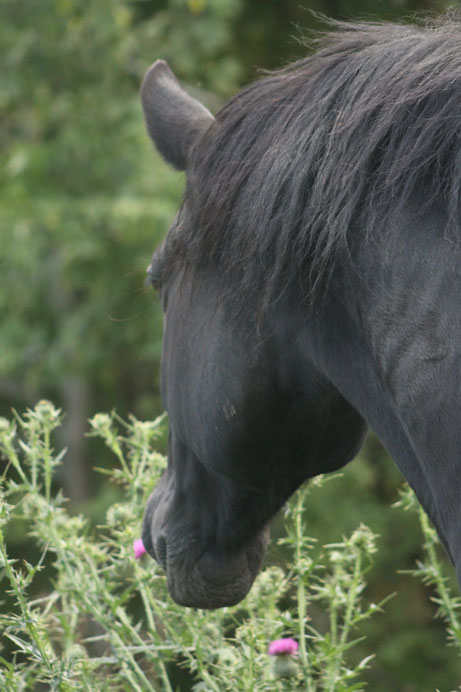
With seventy acres of various grazing available, this horse is instinctively drawn to and manages to eat through the defenses of holy or blessed thistle because it is what he needs
With seventy acres of various grazing available, this horse is instinctively drawn to and manages to eat through the defenses of holy or blessed thistle because it is what he needs
Pier Rubesa’s research adds to biological research by showing another little part of how this comes about through a live, visual aspect. The effects and changes can be measured and can be seen but how they really occur is still not quite understood. It is a type of awareness or universal consciousness that is part of everything all around us.
Energy fields and sounds of different types do have an effect on us either in a beneficial or deteriorative way. Your own sentiments and physical state can also affect those around you. If you could ask someone from two hundred years ago what they thought of this, they might say that it is nothing new. Sitting by a fire at the end of the day with a faithful dog can settle the spirit; watching the sun set with a loved one helps put all things in perspective; being sincere and caring to a friend in need can change that person’s world.
In the February, 2012 article, Window to the World, I mention the feeling of belonging; where time seems frozen; where all seems clear; where the window is open to the world around me and within. It is a state not of thinking but of feeling or simply being. I can consciously try to ‘feel/think’ that way and it immediately changes my perspective. It takes so much pressure off but it is in a removed ‘thought’ state. My survivalist mind quickly takes over saying, ‘That was nice but get back to reality’. The beautiful state in which you can be with life, people or horses has nothing to do with thinking. We make life so much more difficult for ourselves for no reasons other than ego and outside influence.
The beauty and the happiness are in the simplicity. Science will forge onward but live your life with meaning, integrity and happiness. This may be one instance where you do not need to ‘think outside of the box’. It is actually mostly all the information noise around you that has kept you from looking within yourself.
‘’ When all of our intentions and actions in daily life originate from the intuitive wisdom of our hearts, when we feel and act with sincere appreciation, caring and kindness for others – all qualities of the heart – and when we can observe the world around us without the preset judgments of the mind, but rather with the compassion in our hearts, then we will truly be living life from the heart.”
- Doc Childre: www.heartbasedliving.com
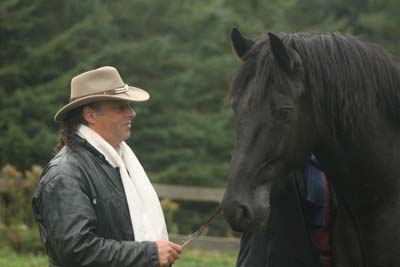
A black feather found at my feet intrigued this horse, named Commanche, and he remained an assistant all weekend of the International Seminar 2012
References:
Dr. Tony Philips: Science@NASA: Nasa spacecraft records ‘Earthsong’ (Oct 2012)
NEXUS-65 : Nos Champs Electriques Interagissent avec la Nature (nov-dec 2009)
Michael Bevilacqua: The Missing Link (2011)
Michael Bevilacqua: Window to the World (2012)
Doc Childre: Heart-Based Living (2007)
Stepping Stones
September 2012
by Michael Bevilacqua
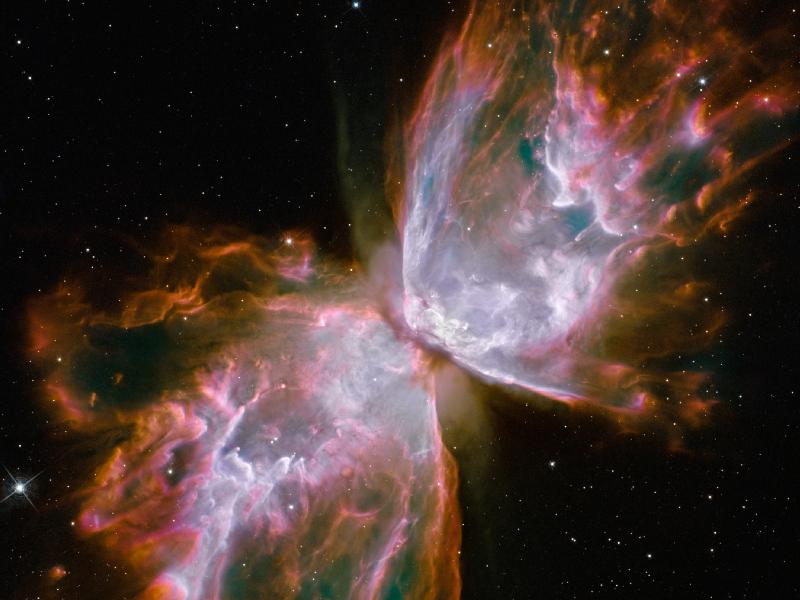
One action has very far-reaching effects: Butterfly Emerges from Stellar Demise in Planetary Nebula NGC 6302 Credit: NASA, ESA, and the Hubble SM4 ERO Team
One action has very far-reaching effects: Butterfly Emerges from Stellar Demise in Planetary Nebula NGC 6302 Credit: NASA, ESA, and the Hubble SM4 ERO Team
Small actions can bring about big consequences. That common phrase may hold true but has a negative connotation to it. For, indeed, small actions can produce big change. Sometimes planned, most often unexpected, the ripple effects of all that you do can be felt either very close by or reach beyond what you ever imagined.
In 1961, Edward Lorenz, a meteorologist with MIT, discovered what is called deterministic chaos. In producing a numerical computer weather model, he took a shortcut by entering the digits .506 instead of .506127. The result was drastically different. After he published his paper in 1963, one meteorologist noted that if his theory was correct, ‘One flap of a seagull’s wings could change the course of weather’. In later papers and lectures Lorenz used the phrase, “Does the flap of a butterfly’s wings in Brazil set off a tornado in Texas”. Thus, we have the well-known term, “The butterfly effect”.
Our personal discoveries, actions or reactions can create a lot of change in our journey with horses. What draws people to horses? The reasons can be quite different for different people but the effects of experience, often through different encounters on that journey or from a single event, can bring about unexpected or surprising changes in people further up the road.
Not all is rosy in life but good can still come from it - very different species sharing holy thistle - Photo courtesy of Catherine Scott
Logic, Emotion, or Simply Being?
There are a number of basic emotions shared by all people and the list of different studies pegs this at five to eight. I would go with five that I believe are universal: joy, surprise, anger, sadness, fear. These can clearly be seen as outward, physical expressions. There are also other emotions that I believe are universal but are more internalized as feelings: love, guilt, jealousy, hate, revenge.
When it comes to horses, is there acceptance of the nature of things or are our actions based on our needs and wants? Horses certainly evoke emotions, in either case, perhaps more than any other domesticated animal. Yet therein lies part of the barrier that exists between humans and horses. It is we putting ourselves at the top of the hierarchy of existence. Living beings outside of the human species are often viewed as “just animals”. If they are not termed as livestock for consumption or work, then the best that can be achieved is status of pet. It is always in terms of something that belongs to us.
A required change in mentality or perception toward other species becomes evident in a story of a family in Ottawa, Ontario, Canada, who nursed an injured crow back to health. The crow can now fly and is free to go but does not go very far. It was never an idea to make a pet of him but he has become a family friend. Pet or friend? There is an important differentiation in those two terms. Walter the crow walks with the kids to school, tags along on bike rides and if the young girl is feeling down, he will fly in through the back door and just sit quietly, nestled up beside her.
That is quite a contrast to an example in, Beyond the Dream Horse, where another young girl wants to make a friend of a slow fly in a cold restaurant. When it is jokingly mentioned that he will simply fly away from the palm of her hand, she tears off his wings to ensure a lasting relationship.
"If you talk to the animals, they will talk to you and you will know each other. If you do not talk to them, you will not know them and what you do not know, you will fear. What one fears, one destroys."
~Chief Dan George
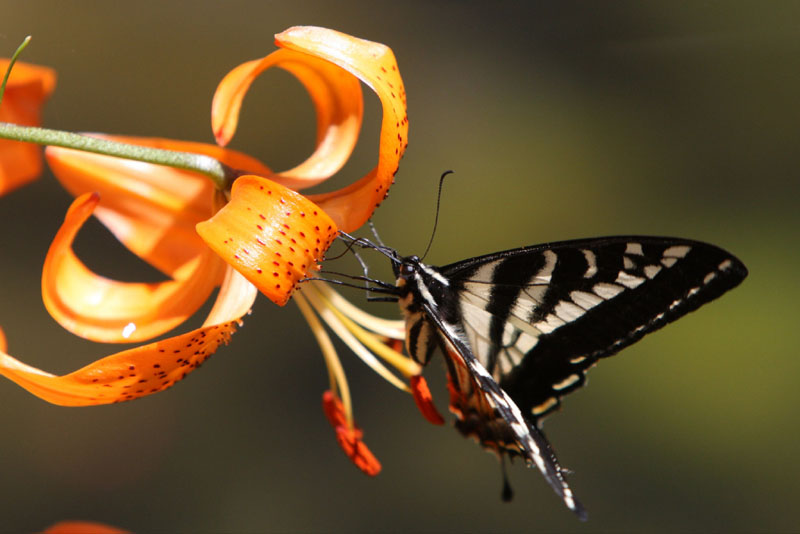
We all grow, learn and change throughout life - Photo by Catherine Scott
The Invisible Compass
When a person is at the point of beginning a search of understanding more about horses starts asking me questions about developing an interactive relationship with a horse, among my own explanations, I do suggest a book titled, Kinship with All Life by J. Allen Boone. It has nothing to do directly with horses but does help explain the shift in perception to other living creatures that is required to have a true relationship.
However, it is mentioned in my book and the May, 2011 article, The Fragile Leaf, that sometimes the allure of being with horses has nothing to do with horses. This has to do with other needs and wants of people. I have seen, and have joked about, women trading in a husband for a horse. It may seem funny on the surface but there are many different layers of emotion that come into play when this really happens. I have never known it to be a conscious decision with any individual but it happens nonetheless.
Of course, people change throughout life and make real, important choices for personal happiness. We all grow, learn and change throughout life. However, when a person may be emotionally drifting on the wind, it does happen that he or she may relate to the horse as part(s) of themselves: strong, honest, vulnerable, smart, fearful, victimized, used, helpless, captive, unnoticed potential. The horse becomes a catalyst in their own lives; to deal with internal issues which have never been previously dealt with or voiced. The worst case would be revenge.
How I have so often seen people who have been betrayed or emotionally hurt in some way, treat other people with the same attitude, in expectation or fear to that which they were subjected in the past. It is often not dramatic. However, it is not the person responsible from the past who pays the price; it is all the people in the future of the victim that pay the price over and over. Sometimes, it is simply a horse that quietly observes mixed emotions through mixed actions. Mostly, it is the person whom, unconsciously, silently struggles with an inner conflict, pain of spirit or unresolved issue.
When it is about people, you may have noticed a ripple effect started at some long-ago point in time bump up against you. All you can do when something seems not quite right is to be neutral yet compassionate, aware and observant. How you treat horses is part of your view of other people and, most importantly, yourself.
I often say to others to teach by example. I do not have the answers to everything, although sometimes, I wish that I do. I do not strive to convince anyone but only hope to inspire even if that seed lays dormant until the sun shines again. Someone very special once took the time to send me a brief message saying that I should write a book. The moment that the positive message was composed created something that changed my life and, from real feedback, continues to touch the lives of people around the world.
In the February, 2012 article, Window to the World, I mention the importance that I felt to save a little bird trapped and exhausted in the barn. I have been asked why I would feel such importance to freeing the bird since there is hundreds, if not thousands, all around me. I did it because I could and it certainly made a difference to that bird. I can only hope that my answer made a positive difference to the person who asked why.
In such a way, you can be the start of a new ripple that may also indirectly touch the lives of many over time.
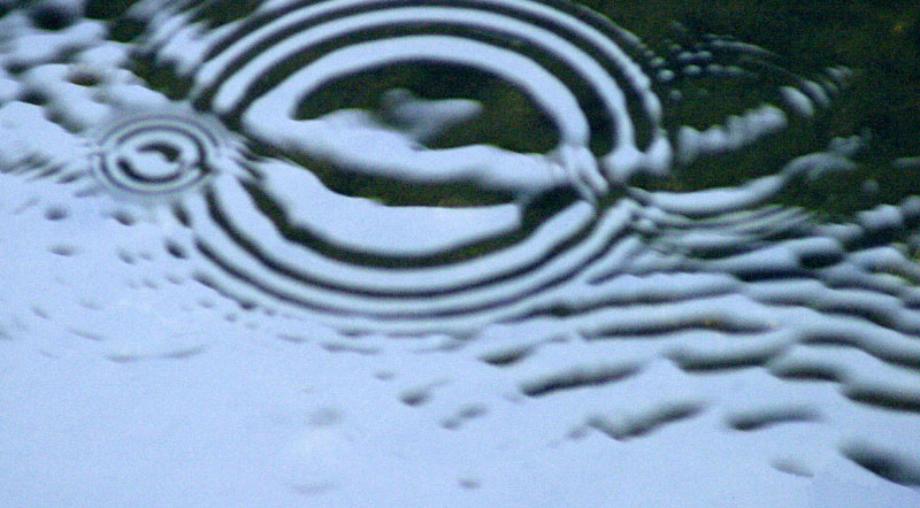
Ripples in water : Photo by Joka2000
References:
MIT News Office: Edward Lorenz, father of chaos theory and butterfly effect, dies at 90
DeeperMind.com: Emotion
cbcnews.ca: Walter the Crow Becomes Part of Ottawa Family (2012)
Michael Bevilacqua: Beyond the Dream Horse: A Revealing Perspective on Attaining a True Relationship
J. Allen Boone: Kinship with All Life
Michael Bevilacqua: The Fragile Leaf (2011)
CanadaHistory.com: Chief Dan George
Wikipedia.org: Chief Dan George
Michael Bevilacqua: Window to the World (2012)
Waves of Change
August 2012
by Michael Bevilacqua

Joy in choice and freedom
Looking back from 2012 over the last decade, it is incredible to see the different waves of change that have developed in the horse world.
The desire by people to live a better way with horses heralded a time of acceptance, development and advancement. There was a mass departure from tradition across a wide spectrum regarding training, equipment, lifestyle, health and health care.
The concept, itself, of a good relationship has evolved. From beautiful descriptions, that really only suited our own ends, it transformed into recognizing the horses’ point of view, respecting it, and adjusting our own behaviour.
Such changes created new career options such as barefoot trimming, massage, energy work, holistic medicine and retail of ‘kinder’ horse gear.
In the article of March 2012, Being Who You Are, it mentions how many people changed their business of using horses to providing health care services for them in various ways.
Since the time of taking an honest look at our own behavior regarding horses and changing our mentality toward them, not only did it bring about initial, significant changes but those changes evolve faster.
Several years ago, an owner of a horse stable asked me about barefoot trimming. The reason was that one of her horses was prone to founder and a year of corrective shoeing did not produce huge improvement. The horse had been de-shod but was still not in great shape. To help the horse and to prove the benefits of going barefoot, I offered to treat the horse for free.
Aside from helping the hoof angle and a detox, I monitored his feeding regimen, cut out the molasses-laced sweet feed that is so common in stables, gave massage and inflammation treatments of arnica and Epsom salt. Small changes and a little TLC allowed significant improvement within one week.
Things were going well until I returned a week later. The owner told me that she was so surprised to see the horse walking about with a renewed spirit that she took him out for a big weekend ride with all the other horses for a four hour trail excursion.
I could understand her happiness but explained that she could not just pick up where she left off. That horse was practically immobile for at least a year and not in shape like before. The hooves still needed time to heal and strengthen. She was happy that I would continue to help the horse recover again during the week. To my dismay, when she saw the horse was doing well again, she once again took him out with the weekend gang.
I began to wonder if I was really doing this horse a favor. This is one example of the waves of change that I currently see happening. The people that chose to care for horses in the type of disciplines or businesses from which they recently walked away are beginning to have moral dilemmas. In most cases, they begin to question whether it is fair or just to heal a horse only to return him to an activity or lifestyle that causes the illness or injuries in the first place.
They may suggest a lighter work schedule but that is often unacceptable to the owner. They may suggest a change of discipline or activity to make the work more tolerable for the horse but that is only good if the owner has other horse options and will listen. The owner is often fully aware of what the physical problem is and what causes it but will use the horse until he can no longer perform. Amazingly, the horse will keep trying until it is completely intolerable or impossible to continue. However, when the horse cannot be satisfactorily ridden, then, just like in the case of the horse I tried to help, they are put down or sent to slaughter.
The changes and the evolution within those changes in the mentality, personal development, and knowledge have been astounding and have taken place in such a short time. It is a quiet awakening that continues around the world. Yet, those who have embarked on a whole new journey still come face to face with the old norm. For many, it is becoming quite disheartening and they have come, once again, to their personal crossroads.
It is like the ancient symbol of Ouroboros: a snake forming a circle and eating its own tail. It represents death and rebirth. Beginning and end; continuity and transformation.
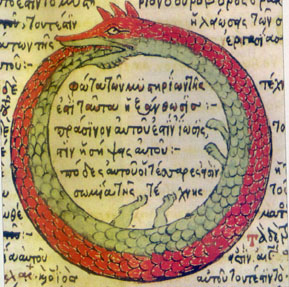
Photo: Serpienta Alquimica : Ouroboros drawing from a late medieval Byzantine Greek alchemical manuscript
People with heart and understanding walk into environments where, even though possibly having come from there, it seems like an alien world, a bad dream or an old thorn in the side.
In the November, 2011 article, The Human Masquerade, there is a brief mention of the heart, its memory and capability of sensing the environment. For some who tend to horses in pain or needless suffering it can be a slow, emotional burnout. That whole situation can be likened to a heart transplant where we often believe that the body rejects the heart but do we ever consider that it is the heart that rejects the body?
In the sense of addressing health issues, in the aforementioned scenario, people want to make a living but also to continue involving something that they love – and that is horses. The caregivers may experience a microcosm of the Western civilization’s approach of treating symptoms instead of dealing with the root problem or getting rid of what causes it in the first place. That is a hard realization that eventually affects those, in some way, who must continue to deal with the standard horse world.
As some people step back to reflect, some of the changes that come from that is a reconnection and renewed joy with their own horses. In focusing what it is that you enjoy in your own daily life you become happier, feel free, and other ideas can begin to flow more easily. Are you happy to get up and start your day? If not, what else would you prefer to be doing? Think about it. We often live in chains but do not realize that we hold the key.
In developing an herb or healing garden for me and the horses, it developed into a learning experience for ‘city folk’ to come and learn what and how to plant. A large gazebo on the edge of the field allows students of art to sketch and paint the grazing horses. How about yoga classes in the morning sun surrounded by forest and horses? Non-horse people still love to see horses and be out in nature but it is the people who are corralled, not the horses! Composted horse manure is not easy to find on the general market of fertilizer but is in demand. Not quite the golden egg of the goose but money could be piling up in the corner of your field or simply serve very well for the herb garden. For those who need an emotional and physical break then a fun reconnection with your horses may be found in ground play. Specific goals of moving through a type of home-made obstacle course can be practiced through horse agility. In the October, 2011 article, <em "mso-bidi-font-style:="" style="">Mirror, Mirror On the Wall, there are also examples of mental exercises for horses by identifying objects, animals, letters and words.
Horses are content simply being horses in their own right. For people who are looking to do more or do less or do something different, the real examples above are just a few practical and successful ideas that can be expanded upon or diversified.
The changes continue and so does the personal healing for both horses and people.
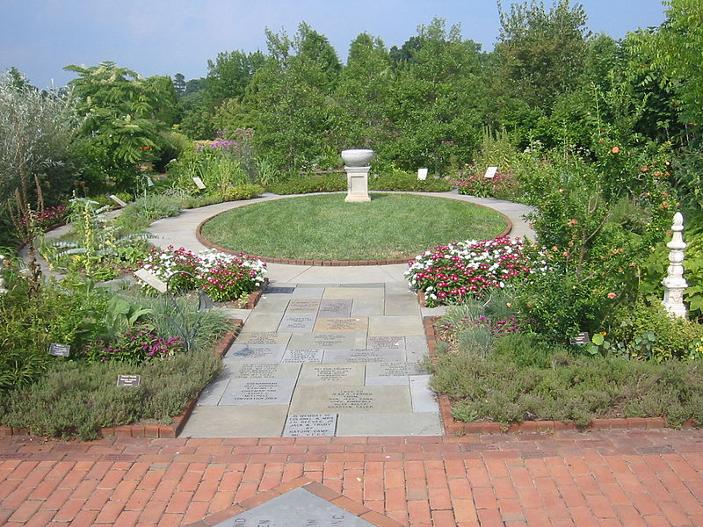
Photo by Terren Peterson: Healing Garden: Lewis Ginter Botanical Center
References:
Michael Bevilacqua: Words of Truth and Horses (volume 1) 2011
Ouroboros: http://www.crystalinks.com/ouroboros.html
Carolyn Crew: Plant a Medicinal Herb Garden for Your Horse
Sangre Fria
July 2012
by Michael Bevilacqua
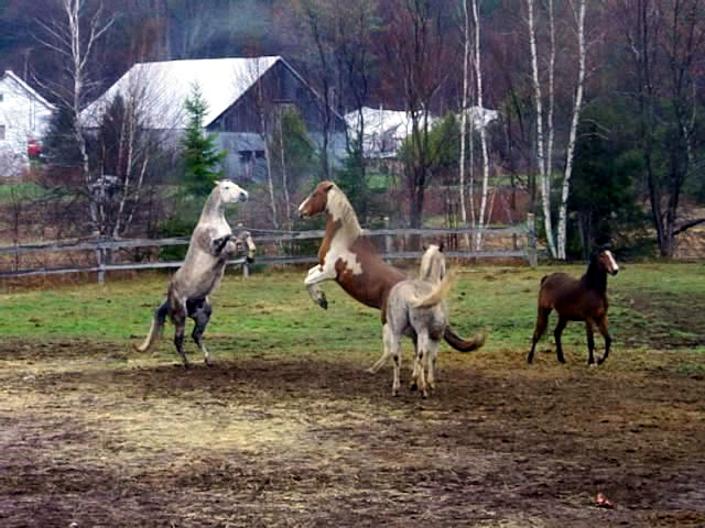
Playful competition can stem from learned games – this is a scene from a tag-team battle for a remnant of a cone
With the growing number of people achieving a new dynamic relationship with their horses, the playful expression of the horses moving in full splendor often gives rise to a common problem. It is less of a problem for the horses than it is for the people. The liveliness of the interaction is well desired, however, the risk of injury increases. There is an important factor that is usually missed along the way. Discipline is necessary and should be taught and understood sooner rather than later.
During the learning experience, most people will be afraid if the horse starts to rear up or just show liveliness. Definitely, most are intimidated at first when a horse is running around playing like a horse! That is a lot of power unleashed and often there are no guidelines established for the horse. Discipline, in this case, means self-control.
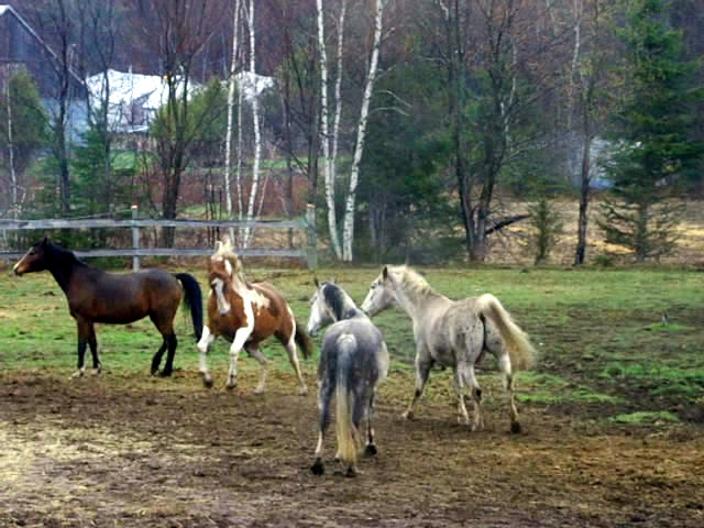
Exploding energy in close proximity with no contact or fear
It is 'sangre fria'. It is Spanish for 'cold blood'. Rather, cool-headed. That's composure. It is being excited but being able to control yourself. It is having mental awareness of what is going on and applying emotional restraint and focus. It applies to you and the horse at the same time.
Doing specific exercises, like Spanish Trot, can still be fun but you have to let the horse know that you are guiding the session. You can be a friend and care for the expression of your horses but during a session, you also take on the role of teacher. If you have a six year old child and walk into a china shop are you going to let him smash plates for fun?
Excitement and play should be guided and calmed down in an instant when desired
This is not about being the typical 'boss' or getting 'respect' from the horse as in the standard horse world. However, it is about teaching the horse what is acceptable or not and even allowing alternate ways to the horse to show different expressions through movement. This applies even if all you want to do is play with your horse. It is clear to the horse that we are not horses but they need to understand that there is a nuance between their habitual behavior with other horses and with us. They are quite capable of understanding and adjusting their behavior to us as opposed to how they interact with another horse.
In ‘Beyond the Dream Horse’ and at my workshops, there is an example of our Arabian mare, Phantom, learning the word, 'gentle'. This started when I would groom her (with hands to find those good spots) and she would start to mutually groom as with other horses such as scraping my shoulder or back with her teeth. My first reaction is 'Ouch!' but I can't blame the horse, so I add 'No' in there and show the horse what is acceptable for me. I could gently stroke the horse’s face with the back of my hand and say the word, 'gentle'. Believe it or not, that is all it takes.
It did not take long that lip tickles on my back replaced scratching teeth and a nose poke replaced grabbing my shirt. In movement, pushing into me to change direction became a circle to the side of me. This is because while we would be moving along together I would always say, 'stay on my side'. The same quality applies to when you are playing or doing things with your horses in intricate exercises.
When I was trying to get Phantom to put a jambette (a raised foreleg) and a walk together to create Spanish Walk, she tended to thrust her hoof down hard - like scraping the ground. I asked for it again, said, 'gentle' and she placed it down ever so softly.
Here is another twist on doing nothing that is very important to do. I would suggest a stand still. Choose two spots that you will walk a straight line from point A to point B. While walking with the horse, you can start to show the horse an acceptable distance that you want. Ask for a stop and ask the horse to stand still. I would then stand perpendicular to the horse, put up both my hands and say stand still. The horse should do just that. No step forward or back or sideways and no turning into you. Praise the horse and walk again toward point B.
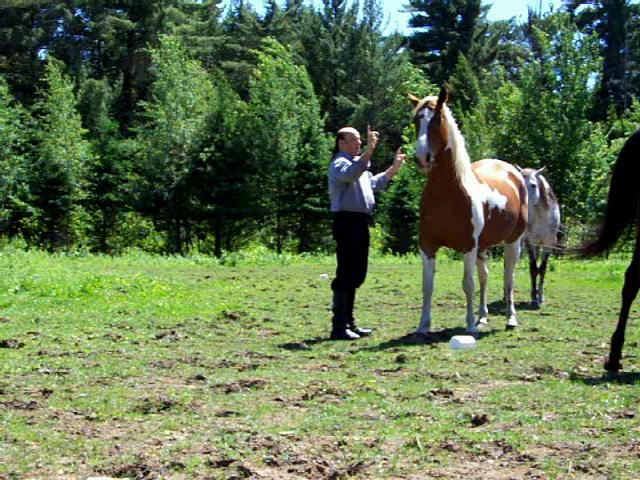
When restarting exercises after a dormant winter or long break basics should be reviewed and perfected
This may not seem too exciting but is an important practice and understanding to be established. It is less carefree than running around at liberty but remember that the horse has a choice. If it is rewarding for him at the end either through play or rewards or both, then he quickly learns that whole process and will try harder to stay focused on you from beginning to end. Since this exercise takes so little time, it all becomes part of an activity involving play.
There is a time and a place for wild play. It is not all the time. By explaining to the horse and teaching what is good or not, without getting upset, then the horse will learn what you like and don't like and how he should behave with you. Your behavior, in this regard, is as important as his.
There have been many times that I went out with an idea in mind but a horse would 'ask' me to do something else instead. That's okay. I like give and take. We have to become aware of what the horse likes and does not like, too. If you are trying to walk a straight line and the horse is all over the place, pushing into you and just seems too animated with no particular idea in mind, then stop the lesson. If I visit a friend who likes wrestling (and I don't enjoy that sport) but he keeps tackling me and pushing me to the ground, I am going to say stop, express that I do not like it, and if he does not want to listen, then I will leave. Maybe it ruins the day that we were supposed to go biking but if he likes being with me, all that I said is not lost. He will learn to control himself in the future knowing that what is natural and fun for him is not fun for me.
Walking from point A to point B with moments of stillness is an important exercise but just one example. A raised hand for a stop makes sense. 'Stay back and wait' to another horse makes sense. 'Stay on my side' makes sense. 'No' makes sense. In any interaction you have with the horses, every moment is a learning experience. Everything is interlaced. If we are on a level playing field with the horse and we can accept a 'no' from the horse, then the horse has to learn to accept a 'no' from us as well.
During play, once initiated, you must guide it, maybe by choosing a direction to run, changing directions, slow down, pick up the pace again and say when it is time to stop.
The basics of the horse knowing that we are fragile and that normal expression as to another horse is unacceptable for us, will also greatly help during play. During those times, all the little corrections count. You must also be mindful of what the horse likes or not or even find ways that are easier for him to understand. You learn how to be with each other and bring out the best with each other.
To sum it all up and make it all seem so easy: If the horse does something you do not like, tell him not to do it. If you would prefer something else, show him how.
A lot of people have the same discipline problem. This discipline has nothing to do with punishment. It means self-discipline. You have to practice it and you have to teach it to your horses.
Be patient, be careful, have fun.
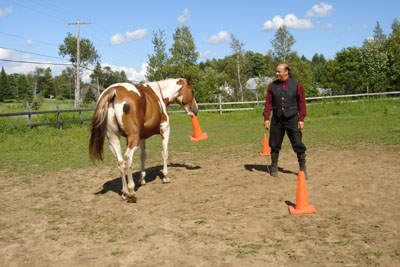
Leo's had enough of 'cadran' - he always uses humour to change my ideas
References:
Michael Bevilacqua: Beyond the Dream Horse: A Revealing Perspective on Attaining a True Relationship(2010), Canada
Alexander Nevzorov: 'Sangre Fria': Nevzorov Haute Ecole Principles (DVD)
*Special thanks to Jennifer Bender of Germany for raising this important subject.
In All Honesty
June 2012
by Michael Bevilacqua
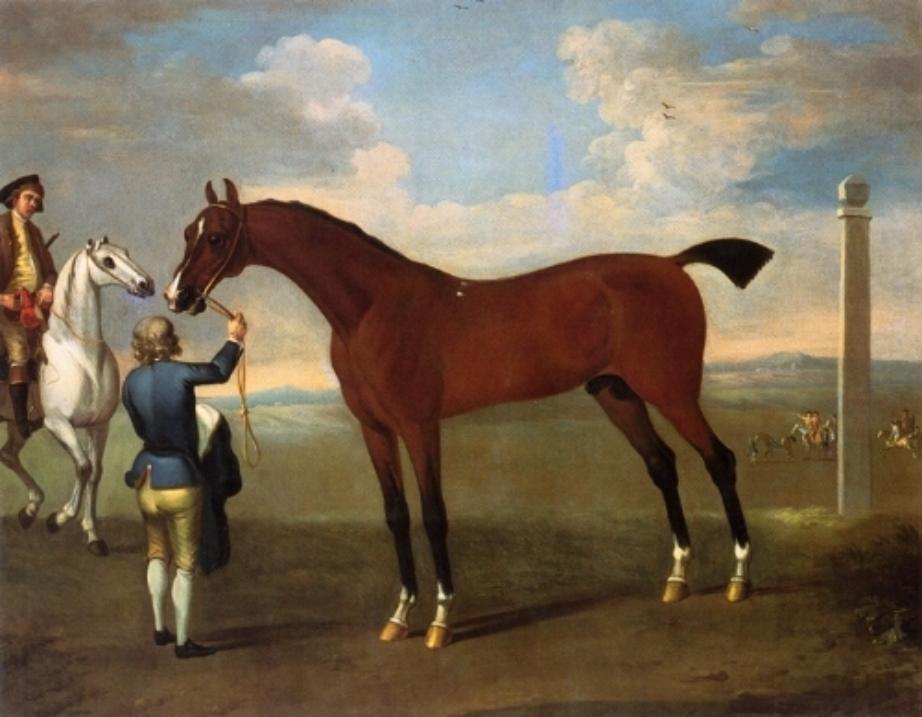
Flying Childers by Jane Seymour (1702-1752) photograph found on the Internet of a public domain painting—mere full-frame technical reproduction
"Heartbreaking Turn for A World Famous Horse - Prospects of a Triple Crown Victory Put Out To Pasture."
That was a Canadian news headline for June 8th, 2012. One day before the Triple Crown, the colt named, I’ll Have Another, developed a swollen tendon in his right leg.
The veterinarian said that they could have got the swelling down and competed but not well enough. The owner, Paul Reddam, choked with emotion, said that the horse had done enough.
Racing has always been physically challenging for young horses, to say the least.
Some people may not be happy but the horse retires a champion. At three years old, his racing days may be over but he will be put out to stud and will make the owners millions of dollars.
You know horses are smarter <em "mso-bidi-font-style:="" style="">than people. You never heard of a horse going broke betting on people. – Will Rogers
In 2005 I discovered a Racehorse Memorial Wall on the internet. The founder, ‘Connie’ is from California and her site has evolved into Equus Editorial and the Racehorse Memorial Wall Worldwide. It has an ongoing list of horses that died as a direct result of the race track.
I’ll Have Another was spared. Was it for compassion or to prolong his money-making capability? He was lucky. So many others that do not bring in significant winnings for fame, fortune or potential are simply written off.
Such news is made into tearjerkers in the news story but they are heartbreaking in reality for those who have real compassion for the horses instead of the sport. Would you not think that the horse racing industry knows the most information about equine health?
At two years old, a horse’s bone development is only complete in the leg up to about the knee. Development continues upward and down along the back until maturity at about age six. Let us look back in history, hundreds of years, and they at least knew that a horse was not good enough for war until at least four years old, if really pressed. What does well enough for war mean? Being ridden.
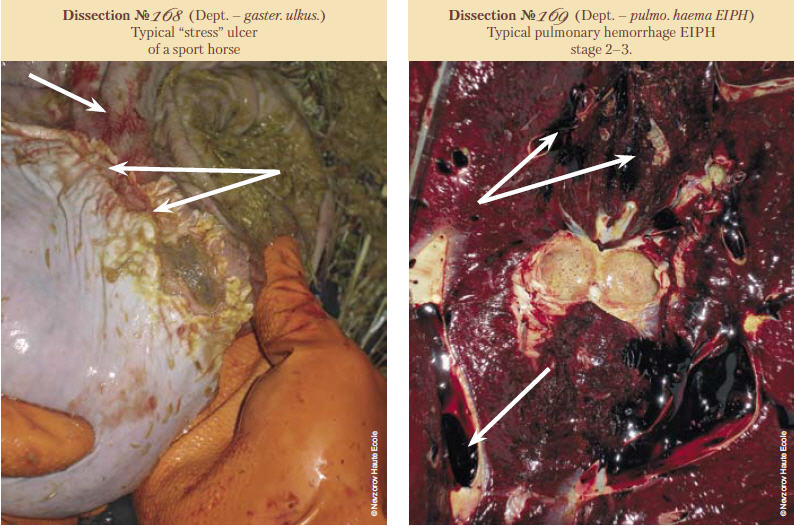
Typical stress ulcer and pulmonary hemorrhage in a sport horse - NHE Research Center
Let’s face it. This is not about caring for horses. The racing industry died in Quebec when it just did not make money to go around for everyone anymore. When this was done, potential ‘stars’ became horse meat. In April, 2012, the neighboring province of Ontario announced a transitional fund to help the tracks since losing $340 million in shared revenues due to the removal of slot machines. Is it a two-edged sword to prevent the deaths of fewer horses? This is not a deal with the devil to prevent the same catastrophe as happened in Quebec. It was another deal reached with another political party to avoid an election call due to the provincial budget.
This can be a big debate among people. Traditions die hard and racing is the sport of kings. Why are people drawn to horses? That feeling can be very strong but do not twist reality into some fanciful dream. For individual horse owners, what most people want, in the end, is just to have their own pleasure of riding a horse. They want to ride without feeling guilty. That’s a new concept that has surfaced since so much more factual information has been presented in the last decade.
People constantly talk about finding a beautiful relationship with the horse but I am so tired of hearing all the justifications of what they end up doing to the horse to achieve that. Most of those relationships are full of lies.
Someone can build a good relationship with a horse so that horse would not freak out if that one person got on and asked to go somewhere. Even then, it can be debated what the motivation really is, however. Is it important to get from that point A to B using a horse? In 2012, probably not. There are so many other ways to do that.
It makes as much sense as those who definitely believe in removing iron shoes from the horse yet still believe in the bit to control. They made a decision for one based on facts about physiological damage caused by shoeing but ignore clearly distinct information about the use of a bit in a horse’s mouth. No one believes that the horse suffers as some pictures that have been captured in a fraction of a second depict. They may say it is all in the hands of the rider or for enhanced contact. The bit is there for a reason, is it not? The horse remembers very well and will certainly submit to a twitch of a pinky finger. Is that the “beautiful relationship” or type of “willingness” you want? Remembered pain from the horse?
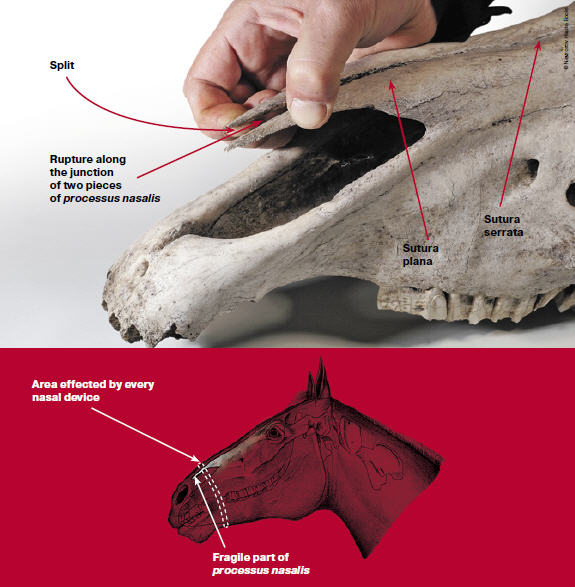
Any kind of alternative control noseband can easily break the ‘nosebone’ connective tissue of processus nasalis: control through pain becomes as easy as the bit - NHE Research Center
How can you train your horse so that you have such an overall beautiful relationship? You don’t. What does love, mutual understanding or friendship have anything to do with training?
A woman once said to me, “I love my horse. We have a beautiful relationship that surpasses anything that exists between what I see with other people at my stable. He loves that copper-rolling bit. He plays with it all the time. It tastes sweet.”
I am so thankful to her for giving me an idea of providing copper lollipop sticks to all viewers of equestrian events. How tasty, sweet, pleasant and natural it must be to have such a piece of metal stuck in your mouth putting pressure on a most sensitive part of the oral cavity after having your teeth ripped out to accommodate it.
After all, even with a fully developed horse, the least that can happen in the long run, to name a few, is kissing spines, kidney damage, ischemia causing muscle necrosis in the back, wearing of the jawbone due to the bit through the thinnest layer of body tissue in the mouth (it is painful, it makes no difference how gentle you are), bone spurs, muscle strain, muscle sprain, emotional derogation of being a slave. All this for the fun of it.
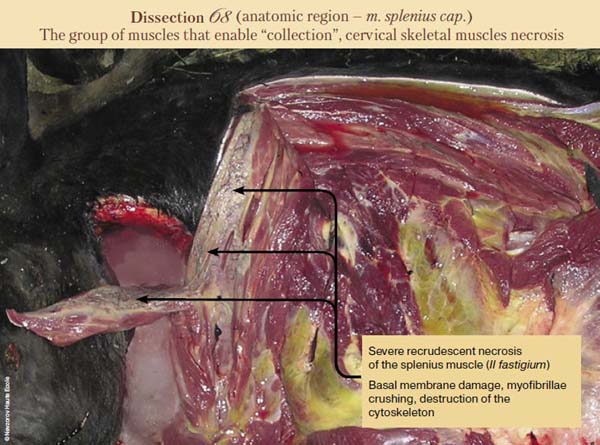
Results of collection forced through bit - NHE Research Center
All the physical and emotional problems that I mentioned about the horse earlier are almost the same problems that we can have. Horses can give us a sense of freedom but put the rider in their place. There is obligation, stress, physical work and “acceptable abuse”. We are not much different physiologically or emotionally. How many horse riders can physically put out nearly as much as the horse does even in respective physical strength, force and stamina? I well recall a horse at a stable that was boxed all week. On the weekend, the owner, much too big for the horse, would ride like crazy all weekend. It would take a week for the horse to recover but it was a steady slide to depression and chronic ailments to being unrideable.
Love and care as much as you know that your horse is required to do certain things and why. Are you happy to jump out of bed and spend a set number of hours in a job? Do you feel the love in your office cubicle, production line, or office? What does it take for you to face a new day? Vitamins, massage, energy drinks, muscle relaxants, mood enhancers, psychotherapy? Well, maybe some horses have a much better life than we do!
The time for horses needing to support our survival has passed. We should give reverence to all that lay dead around the world for us. How are horses classified today? Leisure and sport. It’s all entertainment, at least in the Western part of the world. It is for our personal pleasure, emotional needs or wants whether it is personal, public or business.
It is possible to have a fully understandable and good relationship with your horse. The horse can even carry you for a limited time if he is fully fit and in natural collection. It is very particular.
When I talk about honesty, it has to do with the physical reality before you. I have mentioned in my book and other articles that, in third world countries, using horses is somewhat symbiotic. The horses can survive far better if in the care and protection of humans. The horses, for the humans, are indispensable. Both live a hard life. If you know that you are cutting your horse’s life short because you have to make a living and you know it will prematurely wear him down; possibly kill him, then I respect you for being forthright. With such truth, I would fully expect that you put the emphasis on the care of your horse, with twice the respect towards him, until the end.
I usually like to make people feel good and positive about themselves. It is liberating to see something from a different angle and apply enhancing aspects from life to your life. But that story of the race horse drew me straight back to horses and terrible things I witnessed in my own little history. Somehow, I hope this story helps. It is not easy to write about something bad in a good way.
The youngest, El Primo, spontaneously deciding to show that he can strut his stuff just like the other horses
References:
Racehorse Memorial Wall Worldwide
Larry A. Lawrence, Kentucky Equine Research, Principles of Bone Development in Horses
NHE Research Center; NHE Publishing: horse-revolution.com: NHE Anthologies 6, 9 and 2
Mike Parker: mrmike.com: The History of Horse Racing
Beatrice Fantoni, Canada.com: Province Earmarks ‘Transitional Funding’ for Horse Racing Industry
Dr. Robert Cook:: thebitlessbridle.com: Articles
Mind Over Matter
May 2012
by Michael Bevilacqua
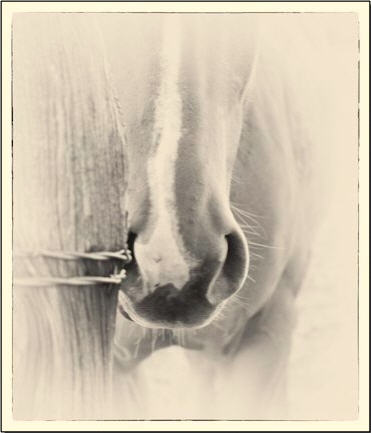
Photo: Muzzle and Fence: Kerry Estey Keith Photography - www.creekandmesa.com
A big concern with a growing number of horse owners who want to teach their own horse is where to draw the line to avoid applying any kind of overt pressure. Of course, what one person may consider pressure is absolutely negligible to another. There are some ingredients that can remove any of the guessing and all of the pressure. Free will, education and fun are all part of it. A simple foundation can produce cognitive development for long-term learning capability and understanding between you and your horse.
To sum up quickly about negative and positive reinforcement: negative reinforcement is applying a pressure in some way to the horse until the horse moves away from that uncomfortable pressure resulting in the desired movement. Positive reinforcement is a reward for the horse when a semblance of a desired move is presented by the horse. The two are often combined in some way in that a negative pressure is applied to get a result and then the horse is rewarded after the result. The reward could simply be the cessation of pressure or what is commonly known as 'release'.
Some may argue that since a horse can feel a fly land on a single hair then any physical contact is applying pressure. Looking through the glasses of a textbook definition, such conditioning could be seen in any situation in daily life with horses or between people. Yet, there is a lot of physical contact going on all the time and it has nothing to do with negative reinforcement conditioning.
People have seen photos of me with horses and sometimes I'm holding a long twig. They are convinced that I am using negative reinforcement even if at an absolute minimum. It is not so. Drawing such a conclusion is normal since a twig in the hand becomes directly associated with what we are so familiar with in terms of a whip being used in training.

The twig becomes a reference to reach where, how high and for how long
With horses, one of the main ingredients that comes into play is free will. If the horse has a choice to stay with you or not then applying any uncomfortable pressure to the horse will most likely make him leave. Pressure does not have to be physical. Intense staring, words with strict tone and gestures could still intimidate a horse.
In Beyond the Dream Horse there is a story about a rescued horse that did not want anything touching him. In observing my work and play with other horses, he eventually invited me to try an exercise with him. It was using a barrel to enhance stretching by placing a hoof on top of it in preparation for Spanish Walk. While walking alongside me, he slowed, swerved behind me and nudged the barrel with his nose. He looked at me and did it again and stood there. He was willing to try and I seized the opportunity. Placing the barrel on its side in front of us, I put my own leg on the barrel and asked him to do the same by saying, 'step'. He copied me almost immediately.
I was so happy that he did it, I wanted him to immediately do it again. That was a mistake. I touched my own leg and put it up on the barrel and he now looked at me with uncertainty. I demonstrated again and again and then touched my leg and touched the tip of his hairs on the back of his leg and pointed to the barrel. Maybe it seemed too simple for him, like he was not doing what I wanted. He became unsure and apprehensive. I could see it in his face. It was too much for him and he slowly turned and walked away. That was already an improvement from him bolting off in a panic.
I went to him and reassured him, stroked his neck and talked softly to him. Those who are fixated on training would say that I positively reinforced his walking away from me. It has nothing to do with that. That tiny lesson was already over. I had to deal with his emotional issue now. That horse made an effort, even initiated it by 'asking' me through his curiosity. I pushed it too far to begin with and should not have touched him. In his uncertainty, I let him know that it was alright. I let him know that I heard his voice. That made all the difference in the world for him.
It is allowing the horse that free will that brought him to me the next day asking me to try again. When horses know that they are free to leave if things get uncomfortable then they are more willing to try again. If the horse gets frustrated, disinterested or keeps leaving then it is up to you to find what it is that you are doing wrong and to find a new way of expressing yourself.
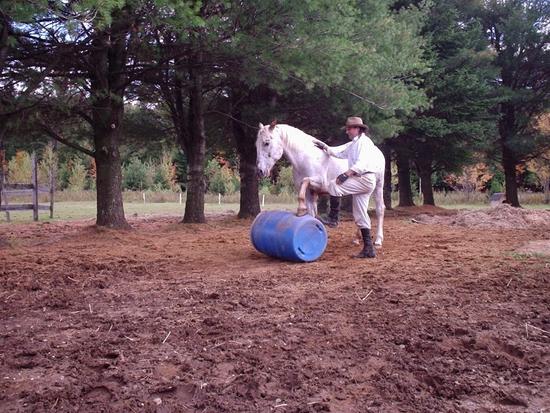
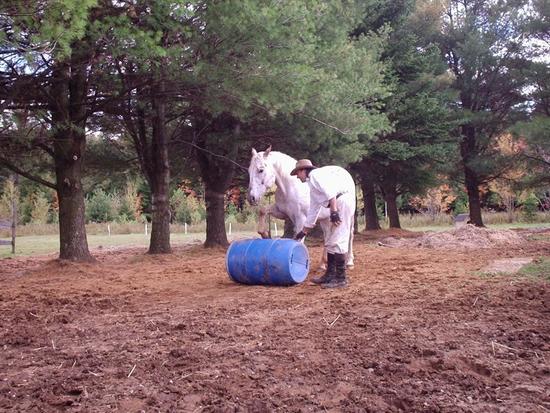
Day 2: Allowing free will and reassurance brings you so much more in the long run
One of the most common phrases in riding schools or standard training tips is, 'You are the boss'. If one is the boss, then that includes dominance and if dominance is present then so is force. To get an open relationship based on free will and true effort for comprehension then you have to turn that old idea upside down.
The twig becomes a pointer and would not be necessary if it were not for having to reach along the horse's body. How could the horse see the pointer if you are asking for a hind leg to move forward under his body? How would he know which hind leg? Touching, in this instance, is not negative reinforcement but a clear indication of what body part I want placed. Standing at the horse's shoulder, I could easily reach to the diagonal hind leg, touch the hairs of the fetlock, the front of the hoof or maybe tap hard in front of the hoof so he could feel air or vibration.
Even if the front of the leg was touched, then the horse would know which leg is being asked for and move the leg forward, as he understands to do through the word, 'step'. He does not move away from it as if the touch was the signal and an opposing pressure. That's the difference.
The horse should already understand what 'step' means with the front legs. It also already starts with indications on your own body. It encapsulates an entire learning process. So, a long reach or touching serves as an indicator, not an applied force. You can take it further by taking the time to teach the horse what left and right means including fore and hind.
From all the little steps taken at the start, all should be clear to the horse including free will, comprehension of movements and your intention. When you work with the horse's mind to help him understand what you are trying to do in the first place, then the intention is teaching and there is no fear, there is no punishment, there is no force.
An example is helping with a dance move. Say your daughter is practicing a dance routine for school and at the last pose you suggest that she bring in her left arm closer to her body and extend her right leg further out. She understands the whole context of what it is that you are saying. There you are explaining what you mean and maybe physically touching but it has nothing to do with negative reinforcement. There is no place for action-reaction conditioning in teaching if you want to build a real relationship based on understanding and trust with your horse.
There is another nuance that comes into play regarding an equal relationship or a true, level playing field with horses. As a role of teacher, in a sense, you are the leader at that moment. Not in the sense of being the boss or the alpha or because horses need someone to follow. You become a teacher, a guide, a friend who takes the initiative to build a way of understanding each other. This also builds the relationship over time. You are trying to get a message across and the horse knows this very well.
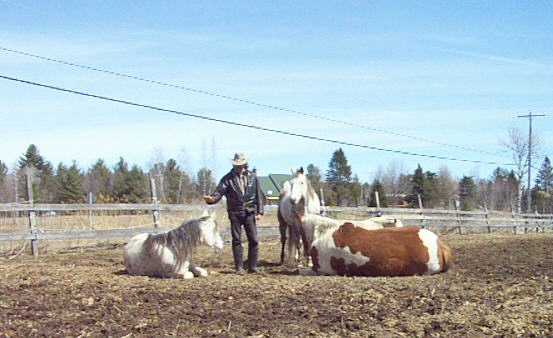
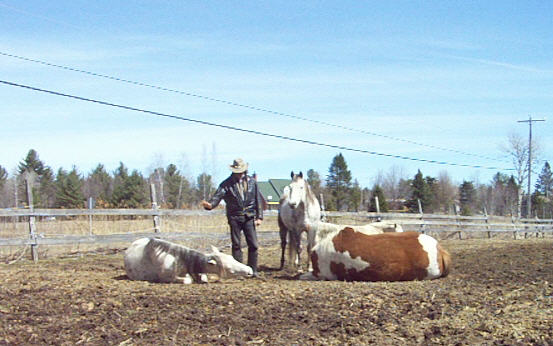
Understanding and trust are far better than training
It takes an amount of leadership with no less respect as any teacher-student relationship should be. Would you consider a mother looking out for the welfare, conduct or safety of a child, leadership? When you are trying to convince a friend who wants to stay home to go out to a movie with you, is that leadership? Not exactly, but it is the same thing in regard to a way of being with horses. It is taking the initiative to build a bridge; to make a connection. During this process, you learn about the horse and the horse learns about you. This is precious. You may only come to realize this over time. It is not articles, such as this that will convince you, it will be the horse.
References:
Michael Bevilacqua: Beyond the Dream Horse, Quebec, Canada, 2010. www.beyondthedreamhorse.ca
The Silent Rhythm of Life
April 2012
by Michael Bevilacqua
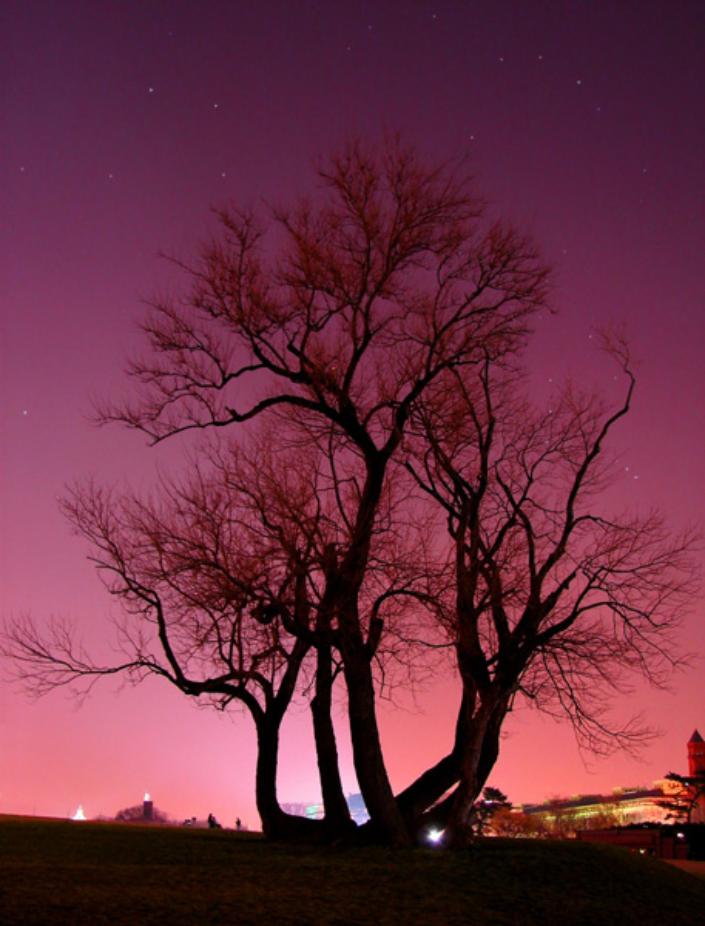
Photo: Monument Unseen by Matt Reinbold
“Nature's music is never over; her silences are pauses, not conclusions.”
- Mary Webb
Our brain is hard-wired for many things and although we can study reactions of the brain we may still be uncertain as to how or why it works the way it does. It shapes our observations, decisions and behaviour within our lives and society. Conversely, regarding horses, we may know why and how they behave but we are missing a big part of their perception. Yet, we do share fundamental semblances and the answer is within us.
A research team led by neuroscientists Drs. Daniel Levitin of Mcgill University and Vinod Menon of Stanford University analyzed durations of notes in 2000 musical pieces ranging from a wide variety of Western musical genres from classical to Elvis. David Huron, while at the University of Waterloo, created a computer program called Humdrum that sampled 400 years of musical history. Through all the different styles and composers, a mathematical pattern emerged based on the length of a note and the duration of the pauses. The pattern is a 1/f (one over f) power distribution. It is not a musical beat or rhythm. We are not actually conscious of such a pattern but what makes music pleasing to us is how our brain responds to what is known as fractal structure.
A fractal pattern is a tiny part of a structure that resembles the overall structure. An example from Beyond the Dream Horse is when I first recognized that the view while looking down at the the earth while flying was quite similar to looking down at the details in the ground while standing on it. There seems to be a unity or semblance represented in different layers of existence. Geometric examples of self-similarity would be a seashell, tree, snowflake, broccoli or a galaxy right down to electrons forming them in the quantum realm. It is all around us.
In short, this pattern or timing found through music or mathematical equation is the same for our heartbeat as well as in the frequency and intensity of Mother Nature's events. Just like the composers who share this inherent quality through time, we also reflect all of the structure of nature.
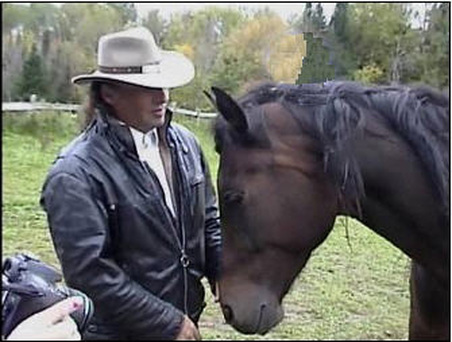
Thought without thinking
In the April 2011 article, The Missing Link, it briefly explains how the brain's hemispheres or types of brainwaves are always a blend of type of thought and mix of layers of thinking. In Beyond the Dream Horsechapter, The Crossroads, I mention the progressive suppression of right-brain thinking due to our school system. Only ten percent of children retain high right-brain creativity by age seven and only two percent carry it into adulthood.
The traditional American Indians believed in using both sides of the brain. They did not delve into neuroscience but they understood the essence of our nature; the duality and how these help us live in harmony. They did not originally have written words. Pictograms, symbols and a very rich language reflect much more right-brain thinking. Although language is a left-brain function, the sentence structure allows right-brain function. The spoken sentences are opposite to English in structure. Their learning involved more alpha states through story-telling, education through discovery, momentary inner quietness when searching for an answer or before speaking, studying dreams for guidance, dancing, music, a deep spiritual connection and power of healing are all part of it.
The balance between insight and logic can flow together. At liberty with horses it is observation and spontaneous reaction that seems to bring human and horse into sync. This is part of the common phrases, 'going with the flow' or 'being in the moment'. It is part of the bond that creates the dance, the play, the happiness in moving together. I once saw a film clip about the acute perception of the horse when it came to cow cutting. The cow is the one trying to get away and yet the horse perceives, through physical 'clues', what the cow intends to do and gets there before the cow does. In my experience of playing with horses in a field, it is this subtle dance in awareness that maintains the momentum and seamless flow of beauty. It is not anticipation of movement but recognition of it without thinking. It becomes an interaction because during the locked-in understanding and effortless focus through this fun, the horse begins to play off the person as well.
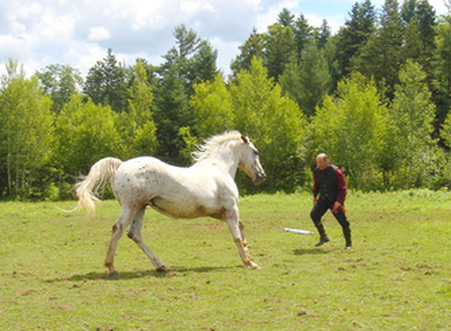
Horses are good at being horses. If you want a good relationship with the horse without force or intimidation then the onus is on you to help bring it forth. They will do just fine being themselves. Trying to explain this is a good example of the left and right brain working together. So many people want something better with the horse rather than the old traditional stuff but are at a loss as to how to proceed. This is a sign of the result of our society and world being built mainly on left-brain thinking.
Preparation is good, reading this may help but even in understanding this as a process you must remember to put the focus on yourself. If you start to ananlyze to what any of this refers in terms of training then it will be a slow slide back into the situation of a human training a subservient animal.
When it comes down to your moment face to face with your horse, you have to immerse yourself in the experience. You can help initiate a true interaction, guide it along but you have to let it develop and not try to make it happen. This may seem to be in conflict with each other but is also an example of mixing the head and heart. Just as a feeling requires the head to express it, a thought from the head can allow your heart to become it.
It is said that the Hopi Indians are the best at expressing non-linear thought. For the rest of us, a lot more can be revealed about ourselves through simple handwriting. The study of this is known as graphology and it is a science. Your left-brain can form the words and put them to paper but they are expression of inner thoughts. The very essence of you can be reflected in how you write on a blank page: where a line starts, where it ends, the spacing, the slant, the pen pressure and in every single letter that you form. If the end result of writing is a reflection of our inner being, then a form of reverse-psychology can take place by consciously manipulating the end result. This is known as graphotherapy. It is proven to work on character traits as well as health.
A tiny, fraction of an example would be how you cross your 't's. If the 't' is crossed high in a lower case letter, it reflects confidence, ambition, overall good self-image. A lower case 'd' with a big upper loop signifies difficulty in dealing with criticism. These examples can have variances within themselves but graphology reveals universal traits that apply to all people. There is a short, online analysis that is very basic, maybe not exact to you, but fun to try. You may discover something about yourself and maybe try some positive changes. It is listed in the references.
Graphology is an in-depth science and there are a lot of services out there. If you want to study it or get an analysis, do your research homework. My first foray was twenty years ago with a great book by Andrea McNichol, Handwriting Analysis: Putting it to Work for You. She is a professional and has a great approach to teaching. Some examples seem almost self-evident and can serve you in your life or business or maybe allow you to see that someone is suffering in quiet desperation.
But who really writes anymore? Not type on a keyboard but put a pen to paper for more than a quick grocery list or post-it note? A real, hand-written letter can convey and mean so much more.
Connecting with horses has more to do with connecting with and grounding yourself. This has largely become a society of 'entertain me'. Spending hours on forums and watching online videos will only take you further away, not only from yourself but also from your horse. It can only be worthwhile if you at least later go out and try something with your horse and try to learn from your own live experience in real time.
Aside from requirements of work or absolute necessity try a no-computer-day. No phone text, no email, no browsing. Choose the day in advance. Computer off! Could you do it? What would you do with that time instead?
When a day goes by there is no getting it back. The sun will not wait for you before it dips out of sight. I have been fascinated with the quiet patience of the Earth. Pick any geographic location and for eons the land or sea itself may have remained seemingly unchanged. However, place the people in there from different eras. One time may be of creativity, prosperity and harmony while another is discord, suffering and bloodshed. As Shakespeare wrote, '...all the world's a stage.' In time, all disappears on the surface. Washed away and blown with the wind only to be replaced with yet another scene of humanity.
And the Beat Goes On...
This is your time. Of course we need time for learning but take hold of every moment for opportunities for pleasure, happiness, sharing and laughing. Of course we need to make a living and have all kinds of possessions, especially if taking care of horses, but everything is transient except love.
This is all about enriching your life through further awareness. Assumptions often abound in regard to people and horses and can steal a moment of openness that would change your life forever. Open your heart; speak up if you need to but be silent if you do not. This is all about communication, respect and an attempt to understand yourself and all that lives around us. I once wrote that I view this world like a big school. It can also be a vacation resort. Our scene on this stage will come to an end, sometimes sooner than expected. Get out there and give it your all.
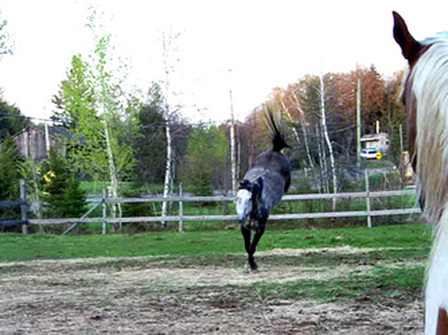
References:
Daniel Levitin: http://daniellevitin.com/publicpage/
McGill Newsroom: The beat goes on: the geometry that makes music pleasing
Michael Bevilacqua: The Missing Link
Allan Chuck Ross: Journal of American Indian Education: Brain Hemispheric Functions and the Native American
ofesite.com: Online Handwriting Analysis
Andrea McNichol: www.brainprints.com
Being Who You Are
March 2012
by Michael Bevilacqua
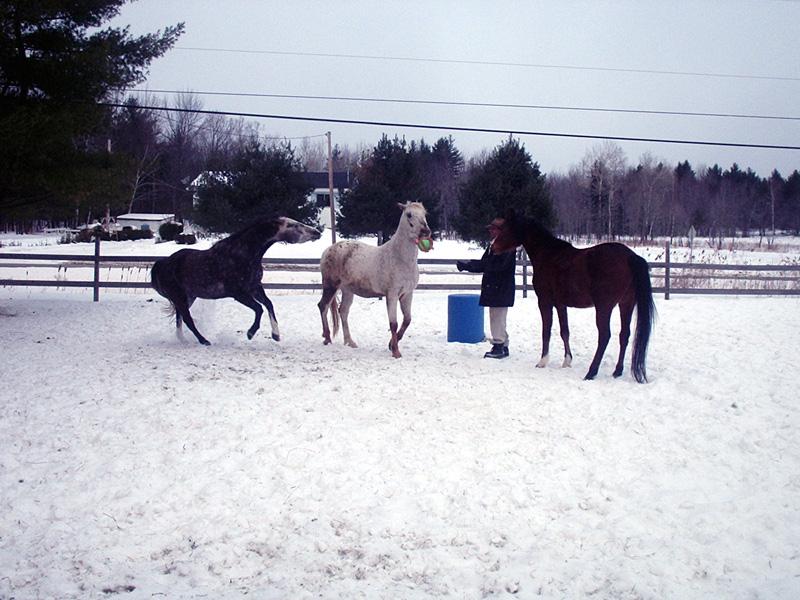
SAFE! Horsing around with the ball
Expression allows you to bring to the world the thoughts and feelings inside of you. It can be an enduring work of art, music or dance. It can be instant in how you act or what you say. How what is said or understood depends upon your frame of mind, particular interests or familiarity of how you are most exposed to it. The word itself can have a different meaning to a mathematician or biochemist.
The greatest comedy sketch of the twentieth century was made famous by Abbott and Costello. Who’s On First is a prime example of two people saying the same thing but understanding in completely different ways.
Communication can be so complex and diverse that a request for a form of expression may only get you an old, well-known phrase. It is the angle that your own thoughts, expectations or intentions are coming from that allows you to entirely understand or misunderstand.
If someone wants to have a better relationship with a horse, what does that mean, exactly? The interpretation of a good relationship can vary widely among all kinds of people.
Two horse barns may proclaim the same principles while they are dramatically different. In the horse world, there are old words that can have new meaning, such as ‘respect’. There are new words that can still hold old meaning, like ‘willingness’ replacing obedience or submission. It still depends what angle someone is coming from in expressing such terms. People can play with words all they want. In the end, what matters is how it affects the horse.
Stepping Out of the Line
In ‘Beyond the Dream Horse’, I describe the day that my entire perception about my own knowledge and horses changed. Starting out as a green horse owner, learning this, learning that, changing this and dropping some other things was quite a journey and growing experience. Except for when I realized that as far up the track I got, despite all the changes I thought I had made, I was still on that same, linear thought. It was by completely stepping off that track that the shift in concepts and my behaviour created a whole new dynamic with horses.
It is from your experience of the past and the knowledge of the present that the horse stands before you as never before. It is subtlety, strength, beauty, fragility and truth reflected to us in the horse.
I was asked in an interview if I believe that a horse has a soul. That question took me aback. The only definitive answer that I could provide is based on what I believe constitutes a soul. How can I even prove that I have a soul? Is it self-awareness? Consciousness?
Horses and other animals in the wild have reflex reactions but they also learn from experience and can analyze a situation and choose from different options. Domesticated horses have acquired a lot more knowledge and learn to adapt to many different situations or circumstances by living in our environment. Experience or knowledge permits the brain to override an instinctual response.
Horses may not have our form of language but they clearly communicate and process information in different ways (vision, scent, sound). Being able to think, express one’s self or feel emotions does not require words. People who have brain injuries and lose the capability of speech are no less conscious than anyone else. When the frontal cortex of the brain that controls language is damaged it opens the door to more sensory based areas of the brain. This can be referred to as the subconscious or true thinking. Temple Grandin very well explains similarities of thought processes between those with autism and horses (and other animals). We all possess hidden skills, talents or awareness that is blocked by our logical end of thinking in language. What has been termed privileged access, can sometimes be artificially induced in normal healthy individuals by temporarily inhibiting neural activity in the left anterior temporal lobe through low-frequency repetitive transcranial magnetic stimulation. (SNYDER/MITCHELL 1999).
If I believe that I have (or am) a soul, because I think, feel emotion or simply recognize myself in a mirror then I would have to conclude that horses, possessing these same traits, do have a soul.
When people begin to see things objectively instead of through their own desires, it can create quite a shift, not only in thought, but in real life. For the first time, at the end of one of my private workshops there was a long discussion among participants about what the next step in their lives with horses would be. A positive and healthy way of interacting with horses was evident. That was not the problem.
Each of the people kept several horses because they ran some kind of horse business. Over the years they saw the repeated problems and ailments, physical and emotional, in the horses they used. As professionals, how would they continue their livelihood, literally and figuratively, if not on the backs of horses? What other options are there with horses other than the use as a commodity for human entertainment and profit? When I began asking myself those questions years ago, I closed my business as horse trainer and riding instructor.
A lot of people have gone into hoof trimming, treating injured horses by focusing on an expertise, combining a myriad of existing healing techniques or setting up a horse rescue or refuge. For the most part, they are helping horses that are in the type of businesses that they walked away from.
When most people say that they are searching for answers and truth, what they really want is to hear what suits them. How often is the answer really coming from the horse?
Anyone who provides research results provides intellectual arguments. It does not matter how logically it can be presented in layman’s terms. What makes people change is not science on a printed page. It is most often the personal emotional factor from every horse owner that will effectuate change. It is very rare that raw data will change someone’s habitual beliefs. Especially, if people are happy doing what they are doing, they become selective in which facts they choose to believe. If it stirs reflection, it is because it touches a part of that person’s emotion regarding directly or indirectly his or her own horse. The information must strike a chord that is already lingering somewhere inside.
The term relationship is often further expanded to include the overall cooperation of a horse according to what a human wants to achieve. That causes problems. It is easy to ask a horse to do what they naturally do. That is the horse moving in full splendour, playing and capable of intelligent thought. Regarding free will and respect, people can go off course when they are trying to get the horse to do what the horse does not want to do.
When a person goes off to find a technique or other tools to suit their ends, those options may not always fit the person’s character. They may try to adapt to some other way other than their own normal way of being. Whether it is by working with a horse’s mind in free will or physical force or psychological domination, if it does not fit a person’s character then it does not work. There is, however, one common effect: This can cause disappointment, self-doubt, lack of self-confidence which, in turn, certainly affects the fundamental relationship with the horse.
Have you ever come across a horse that you once knew well years before? They do remember you – far better than most people realize.
The basic relationship between you and your horse is not something that can be found in a book or taught to you by someone else. It is very personal and unique between both you and your horse. It is you who can get the ‘feel’ of what kind of mood your horse is in more than would a stranger who is looking on. Likewise, the horse knows your moods, form of expression and way of being. That is very personal and so much can develop and move forward in a personal relationship without you trying to achieve an exact outcome because you are simply being who you are.
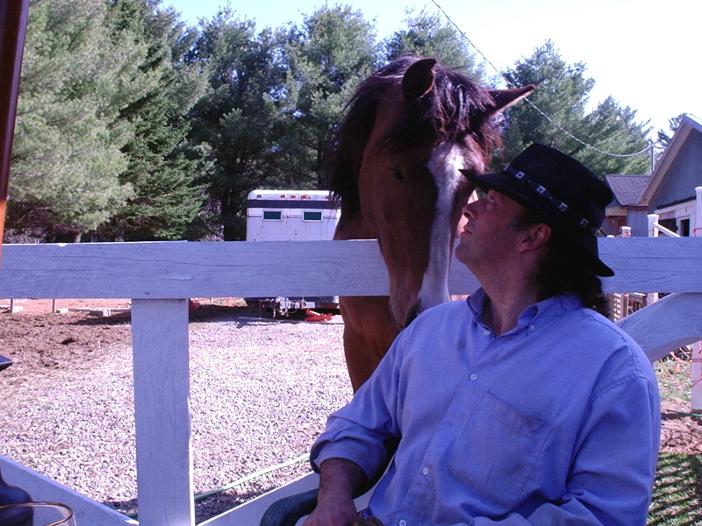
Window to the World
February 2012
by Michael Bevilacqua
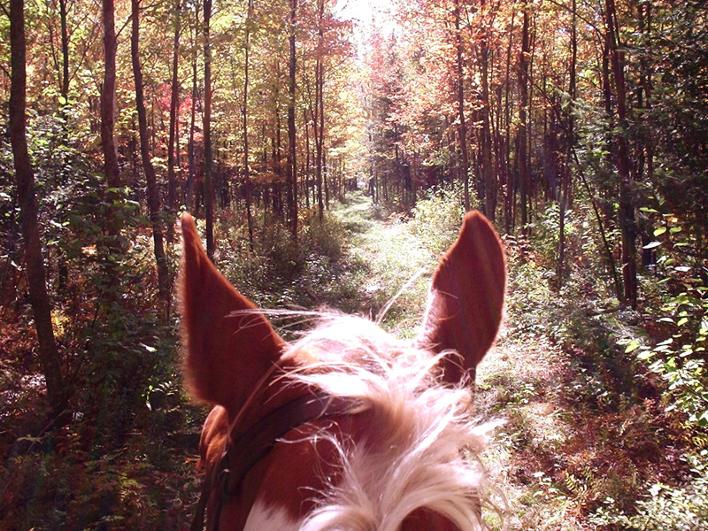
“Through the trees we could hear and see the dirt bike aggressively speeding up the hill. My horse had seen motorcycles before. I don't know why that one startled him. It was sudden. Maybe it was the full, black helmet and visor. Just a black, shiny ball for a head. I always was conscious of being gentle using a bit. I quickly took up the reins; maybe harder than I intended. My horse’s bad reaction to this made me again make quick pulls to the right, then the left. He reared slightly and bolted. There was no stopping him. Leaning forward, I panicked, pulled hard and he jerked his head up, breaking my nose. In that momentary daze, I struck a low branch, toppled over the back of the horse and have been paralyzed from the waist down ever since.”
I heard this story in 2005, from one of the many different people who came to visit when I used to be a Bitless Bridle representative. We talked for a couple of hours and she told me that she really liked it and had no problems with her horse while using it. She still rides, even on trail. I related some of my own stories about different horses that did so much better without a bit. The fact that this woman in a wheelchair still went riding did surprise me but told her she was wise to use the Bitless Bridle, especially after the escalation reaction due to the bit.
“No,” she said. “If I go on trail I still use a bit for safety.”
I do not recall my reaction but it was either a blank, frozen, momentary stare of disbelief or feeling like I just got hit in the head with a rubber mallet. I remember that conversation because, after all the talk and that statement, I still am not sure what her real intention was for the visit. I know that I have mentioned stuff like this before. This is just a specific example of how I simply cannot grasp why someone would continue to follow a norm instead of doing what they personally know works.
In 'Beyond the Dream Horse', I mention a woman who rode bitless for the first time only out of total desperation. She had already given up and was actively trying to sell the horse. It was because of her 'nothing to lose' attitude that the outing was the only decent, actually, pleasant ride that she had in two years with her Arabian mare. However, it was the one and only time. In her joy, she returned to the barn during the week and the people that were there convinced her to use the bit for her 'crazy' horse. The rides were once again a disaster. When I finally did see her again, I remember her sitting in sadness and confusion as she awaited a buyer who was coming to pick up the horse.
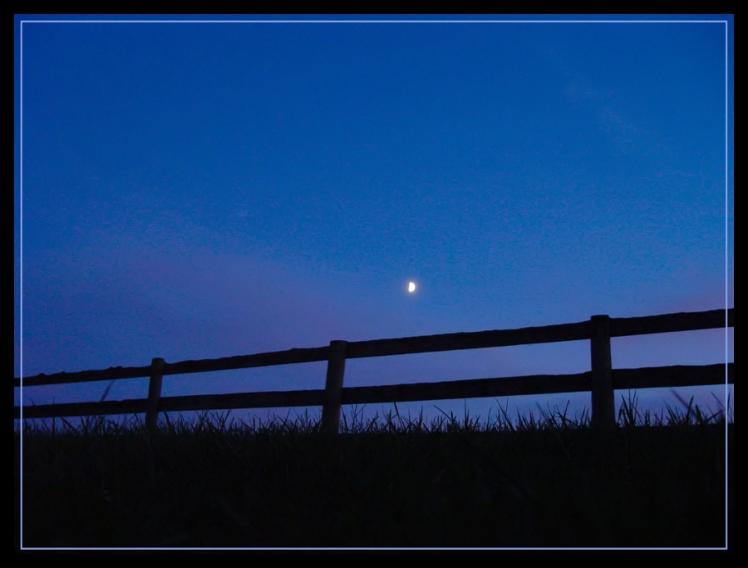
Photo by: Clearly Ambiguous: everystockphoto.com
These simple references to the past are when bit or no bit; shod or not were the only main concerns. Today, there is so much more to consider in almost every aspect of the horse. Yet, history repeats itself. Maybe it has got even more complicated. It does not need to be.
One of the main changes is that people want to be able to learn how to interact with the horse instead of hiring a trainer. They want a better life for the horse and how to communicate better. Many look back and have regrets about what they did, thought or did not see about horses. That is normal. It is proof that you have grown with experience and become a better person. The phrase, ‘It’s not what you did that defines who you are but what you do now that defines what you will become’, always holds true. (I tried to find who wrote that but the closest I got from searching online is something from ‘Batman Begins’!) Anyway, what I like about that phrase is that it is perpetual.
I have written before that it is so important that you are truly honest with yourself in what you want with horses. This will clear a lot of the confusion. When you can define what it is that you want, or at least, what it is that you do not want, that will enable you in being able to be absolutely clear to your horse.
There are times, when all finally comes together or all of anything does not seem to matter at all.
It was a warm, summer morning. The horses were out in the field grazing and I walked into the barn to do the cleaning. Over the years, I showed them to either do their business in the barn or in two areas of the field. It certainly helps me with management and time. I suddenly got startled by a noise at the window. There was a little, grey bird fluttering between the wire grill and the window. I slowly approached and started to put my hand through the grill expecting him to fly away from me and find the way out the door. It just slumped on the ledge, leaning against the window. I thought it just died of a heart attack. Looking at this little thing that could fit in the palm of my hand, I said to myself, “Oh no, no. I don’t want this to happen!”
I ran outside to pull the window out of the frame. When I started to unlatch it on one side, the bird was back to fluttering against it. Obviously he did not die. Maybe he was just exhausted. I worked as fast as I could to unfasten the rusted latches telling the bird, or talking to myself, that I could open the window and he could just fly away. I finally got it loose and swung it open to one side and he flew off, barely making it to the nearest tree branch. I looked at him at said, 'I'm glad you made it. You'll be ok'.
The next day, while heading back out from the barn, a little, grey bird came down from the line of pine trees off to the right of me. He flitted for a moment in the dry dirt just in front of me, making a little puff of dust, and flew right back to the branch. When he had momentarily touched down, we actually made eye contact. He looked straight at me. That moment seemed to be frozen in time. Looking up to the tree, there were two birds perched there. I stood in shock. Was that the same bird I freed the day before? Did he just say, 'Hello' with his little acrobatic flight? Get my attention? I like to think so because I have never seen a normal bird act that way or fly up to a person. It made me feel really good. Whether that was the case or not, I now put out some bread and seed at the base of that tree. They are now regular visitors. Maybe they always were but I never noticed it before.
Spending time outside with horses has allowed me to function or think on a much simpler level. Ironically, it is this simplicity that permits a much greater awareness and insight to ourselves and the world around us. There is a feeling I get sometimes of complete peace and unexplainable happiness. Stepping outside and suddenly being aware of hearing the birds in the trees, feeling the sun and how the light fills everywhere; sensing the wind touch everything; sensing the horses' presence instead of just seeing them in front of me. It is almost like a type of lens has switched in my perception of all around me.
Words are so commonly used such as love and light, inner peace, all is one... but how many people really feel what that means? Really feeling a togetherness, unity or same 'wavelength' with all of nature? The last time this happened it was sudden and brief. I moved on to continue doing what I had to do. That little window where everything seemed to be allowed to flow in and out at the same time closed again. But I remember the moment; the feeling and thinking that I would be perfectly accepting and at peace if I died at that very moment. It was not some kind of existential, intangible idea of a god. It was physical, real, with a true sense of belonging – not to something – but part of it.
I don't make claims of knowing anything special. People have contacted me, earnestly asking questions about some of the stuff (other than horses) to which I have alluded or wrote about in previous articles. I have no belief of being some kind of spiritual leader, nor having some great insight, otherworldly wisdom or even being on a path of enlightenment. I think most people have had little moments like this, even if it is from a dream that just leaves you feeling good all day.
You may have seen a significant difference in how horses react with different people. It could be an old school horse or an unridden horse in a field. With one person the horse could be totally engaged, energetic, interested. With another person, you might think the same horse knows nothing at all and is completely disinterested. The key is to be the best of who you are, happy and at peace with yourself. Your attitude, certitude and confidence will not change the world but the rest will begin to fall into place in the world around you. Especially when it comes to horses.
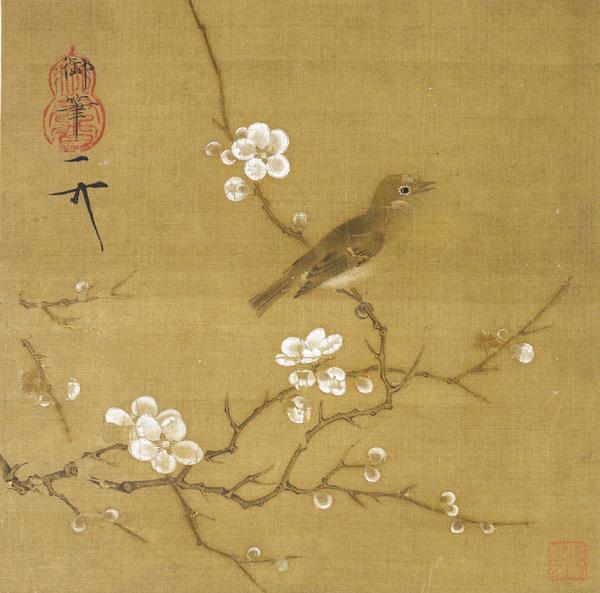
Zhao Ji (1082-1135) Eyes Embroidered with Plums : chinaonlinemuseum.com
The Gift
January 2012
by Michael Bevilacqua
Several years ago I submitted an article for Equus magazine about a personally moving experience in giving private classes to a deaf teenage girl. I am not going to repeat the article, but wanted to share some important points.
She had difficulty at regular riding stables for comprehension, keeping up the learning speed with the others or being noticed as different. The girl had no problem with learning but the instructors had little time or patience to devote or adapt with special attention in group classes. The short-lived lessons mostly ended in tears. When the father of the girl called me, I thought of how I can read my horses’ reactions, how I learned to show them what I wanted, how to find the best way to help them to understand. Those were the first thoughts that popped into my head. In a flash I saw all the different situations with the different horses. Many that were also once considered outcast. I had already stopped giving riding lessons to the public yet, for some reason, accepted this special request for the girl.
At that time, the horses were already bridle-free. I was still dragging some of my ‘trainer’ mentality but the horses were still in the process of showing me a simpler way. They had already demonstrated that they would tolerate a strange rider for a short time but would also gently make it clear when they had enough by stopping and looking over to me. This was a period when I began to fully realise that the relationship formed with the horses was not transferable. The horses were not ‘trained’ as people understand in the typical sense. It certainly was not like programming a machine and handing it over to another person and showing which buttons to push to make it work.
Through that girl, I saw more into my future than I realised. Here was a girl taking standard riding lessons when she really wanted to be accepted by and share with the horse. She not only was happy to spend time with them but interact with them in a playful and loving way that was usually scorned at back then. The only conventional activity with the horse at that time was brushing, tacking up and riding. In some stables, simply talking to the horse was forbidden.
She had a spirit and an outlook toward the horse that many of my private students shared. It is a mentality outside of the norm and it is evident that many others share this view and feeling but stayed ‘in the closet’ until an opportunity presented itself.
I did my best to communicate with the girl, even at the risk of seeming silly. My facial expressions were exaggerated and expressive and my whole body became a tool of communication. I would show her what to do and what the horse was supposed to do. She found it sometimes quite amusing, but it was working. She was progressing well and the horse was just great. He was patient and not minding my change in behaviour. He knew what was going on. I think he was trying to help this girl as much as I was. The horses and I accepted her and we turned out to be just what she was looking for.
In ‘Beyond the Dream Horse’, I mentioned a wave of change that was occurring in the horse world. The barefoot movement was part of that and has really taken hold. Keeping the horse barefoot and in a more natural environment along with understanding more of the physiology of the horse has become very common for the average horse owner. What a difference from roughly ten years ago. Around here, when just one person in a stable decided to permanently remove horseshoes and do their own trims, it was shocking. They would be lectured to, ridiculed, ostracized. It caused such furor in regard to the long-held established norm as when it was first presented that the world was not flat.
Although the benefits of normal hoof function is based on medical science, it took very long for people to make the switch. More than science forging the way, it was the people who were bold enough to stand by their horses instead of a human dogma. In the end, it was the horses that proved the advantages of going barefoot to the nay-sayers and doubters.
Nevertheless, the phrase, ‘If you are going to ride, the horse needs shoes’ still persists (mostly coming from farriers). Did changes come about because of logical reason or because of popularity? If a new boarder with cemented, traditional beliefs were to begin boarding at a stable where all horses are barefoot, people understand the evident terrible function and effects of bits and maybe some do not even ride their horses, would the person change through becoming more educated or through social pressure or wanting to fit in?
In the article, ‘The Fragile Leaf’ of May 2011, I mentioned a sometimes observed disassociation between what people would say and what they would do. I still wonder about this when someone may talk about the importance of a ‘natural herd’ lifestyle for the horse; explaining how they are trickle eaters, need constant access to fresh water and the company of other horses; respecting the horse and even allowing a horse a choice. Yet, they will take the horse out for hours on a trail ride at least once a week. Many people, at least around here, will add that a horse does not need a bit but since they are out on a trail, they will use one for ‘safety’. When I see this common contrast, I ask myself where all the arguments I just heard them proclaim about a natural herd lifestyle go.
Do people just adapt to changing ways without really changing their own views or personal behaviour as if they were simply following a social trend or fad?
A change of viewpoint and way of life should be a normal progression rather than adopting a method as a false pretence in order to attain a personal desire. The double-standards of human viewpoints and our self-proclaimed superiority has been mentioned before in the articles and the book. In the August article, ‘Romantic Notions’, the horse is often referred to as a divine gift, yet, look at what we have done to the horse throughout history. As humans relating to a different species it should be no surprise considering our nefarious behaviour just among ourselves.
A breaking story of January, 2012, was of a ‘human zoo’ in the Andaman Islands, north of the Equator in the Indian Ocean. A primitive tribe that discovered civilisation in 1998, are now drawing paying crowds of tourists who toss scraps of food to them to make them dance. It is equally noticeable how media outlets are posting videos and pictures of bare-breasted native women. Never would a news story depict a semi-nude ‘civilised’ woman, even from a nude beach! Why, in 2012, are the ‘primitive’ women not considered part of the prevailing man-made shame and denial, the facade of laws or personal respect concerning human bodies? Sometimes I really do wonder about changing people’s views toward the horse. It seems we have learned very little within our own human history. With the negative public reaction from this story, I am relieved to see that the world is also filled with decent, caring people.
That young girl is one of them. We are always learning; always changing. Perhaps, erroneously, I followed too much of a habitual standard in showing this girl how to ride. On the fifth day, she showed up with enthusiasm. After I called the horse from the field to the stable and she placed the saddle onto the horse, she lowered her eyes and looked off to the side. I knew she was thinking of something. I guess I should have seen it coming. She removed the saddle and placed her hand on the horse’s back. Looking at me, she put her hand to her chest and then put her hand back onto the horse. I smiled, nodded yes, and went to put the saddle back on the rack.
It was not the riding that was important to her. She was a natural, for sure, but it was not what she was best at anyway. Very early on, with other students, I learned to help some of them flow with the horse more than load them with info about proper posture and positions and movements. A calm, relaxed, balanced rider would become worse trying to focus on proper textbook riding rules.
The beauty of seeing that girl walking with a horse in the field was the naturalness of it. Actually, it seemed more surreal. She could speak, but seems she chose not to. She rode a short, preset course, but then dismounted. In the field, she was walking alongside the horse, laughing, plucking up grass and giving it to the horse, and seemed to be talking up a storm with him. If not with words then certainly through her entire being. He was free but followed her around, also played and stayed with her.
The father and I watched from afar as he stood in silent joy, tightly clasping his hands with tears in his eyes. I felt a similar state after the way the girl hugged me to say goodbye. It filled me with a sense of love that I just cannot quite describe. It seemed to have changed me. It makes me think of Dr. Masaru Emoto’s transformed water crystals. The horse did something that I don’t think he has ever done for me - he neighed when they pulled out of the driveway.
I wanted the experience to be memorable for her in a positive way. I only presented an opportunity and let things unfold naturally but it is she who gave me one of my greatest lessons and one of my dearest memories. During that week, I saw what a true change in perception of the horse is really like. Because of a young girl following the pureness of her heart, there was a gift created and shared by all.
References:
Michael Bevilacqua: Beyond the Dream Horse
Michael Bevilacqua: The Fragile Leaf ; The Human Masquerade
Online Mail: Shame of the Human Safaris
United Earth: The Water Crystals of Masaru Emoto
Office Masaru Emoto: Water Crystals